3. VLL Services
This section provides information about Virtual Leased Line (VLL) services and implementation notes.
3.1. Circuit Emulation (Cpipe) Services
| Note: CES services are only supported on 7210 SAS-M operating in the network mode. CES functionality requires a T1/E1 CES MDA card to be installed in the expansion slot on the 7210 SAS-M. |
3.1.1. Cpipe Service Overview
Cpipe service is the Nokia implementation of TDM pseudowire VLL as defined in the IETF PWE3 working group.
The 7210 SAS devices can support TDM circuit applications that are able to transport delay sensitive TDM traffic over a packet network. For example, in case of business that use legacy T1/E1 interfaces, Cpipe services provide transport services. Cpipe services over MPLS tunnels are supported.
The TDM traffic is transported encapsulated in a TDM VLL over the packet switched network (PSN). The entire T1/E1 frame or part of a frame (n × 64 kb/s) is carried as a TDM VLL over the PSN. At the far end, the transport layer frame structure is regenerated when structured circuit emulation is used, or simply forwarded as part of the payload when unstructured circuit emulation is used.
3.1.2. Cpipe Service Modes
Cpipe services support unstructured circuit emulation mode (SAToP) as per RFC 4553, Structure-Agnostic Time Division Multiplexing (TDM) over Packet (SAToP), and structured circuit emulation mode (CESoPSN) for DS1, E1 and n × 64 kb/s circuits as per RFC 5086, Structure-Aware Time Division Multiplexed (TDM) Circuit Emulation Service over Packet Switched Network (CESoPSN).
3.1.2.1. Unstructured Mode (SAToP)
Structure-agnostic TDM over Packet (SAToP) is an unstructured circuit emulation mode used for the transport of unstructured TDM or structured TDM (where the structure is ignored).
| Note: The word agnostic is used in RFC 4553, but it is not used in the literal sense. The meaning of agnostic in this case is unaware or independent. Therefore, structure-agnostic is used to mean structure-unaware or structure-independent. |
As a structure-unaware or structure-independent service, SAToP service does not align to any framing; the framing mode for the port is set to unframed. For structured TDM, SAToP disregards the bit sequence and TDM structure to transport the entire signal over a PSN as a pseudowire.
3.1.2.2. Structured Mode (CESoPSN)
Structure-aware circuit emulation is used for the transport of structured TDM, taking at least some level of the structure into account. By selecting only the necessary n×64 kb/s timeslots to transport, bandwidth utilization is reduced or optimized (compared to a full DS1 or E1). Full DS1s or E1s can be transported by selecting all the timeslots in the DS1 or E1 circuit. Framing bits (DS1) or FAS (E1) are terminated at the near end and reproduced at the far end.
When CESoPSN with Channel Associated Signaling (CAS) is selected, the ABCD bits are coded into the T1 or E1 multi-frame packets, transported within the TDM PW, and reconstructed in the T1 or E1 multi-frame at the far end for each timeslot. CAS includes four signaling bits (A, B, C, and D) in the messages sent over a voice trunk. These messages provide information such as the dialed digits and the call state (whether on-hook or off-hook).
The mechanism for E1 CAS is described in ITU-T G.732. When configured for E1 CAS, timeslot 17 carries the signaling information for the timeslots used for voice trunking. Each channel requires four signaling bits, so grouping 16 E1 frames into a multi-frame allows the signaling bits for all 30 channels to be trunked.
As shown in Figure 15, timeslot 1 of all frames within the E1 multi-frame is reserved for alignment, alarm indication, and CRC. For Frame 0, timeslot 17 is reserved for multi-frame alignment bits. For the remaining 15 frames, timeslot 17 contains ABCD bits for two channels.
| Note: For E1 CAS, timeslots are numbered 1 to 32 on the 7210 SAS. |
For T1 CAS, the signaling bits are transferred using Robbed Bit Signaling (RBS), where the least significant bit in the channel is used periodically to transport these bits instead of voice data.
T1 CAS is supported when ESF or SF framing is configured. ESF framing uses a 24-frame multi-frame and transfers all four signaling bits (ABCD). SF framing uses a 12-frame multi-frame and transfers only the AB bits. The signaling bits are carried in the least significant bit of the following frames:
- A bit in frame 6
- B bit in frame 12
- C bit in frame 18
- D bit in frame 24
Figure 15: E1 Framing for CAS Support in an E1 Multi-frame
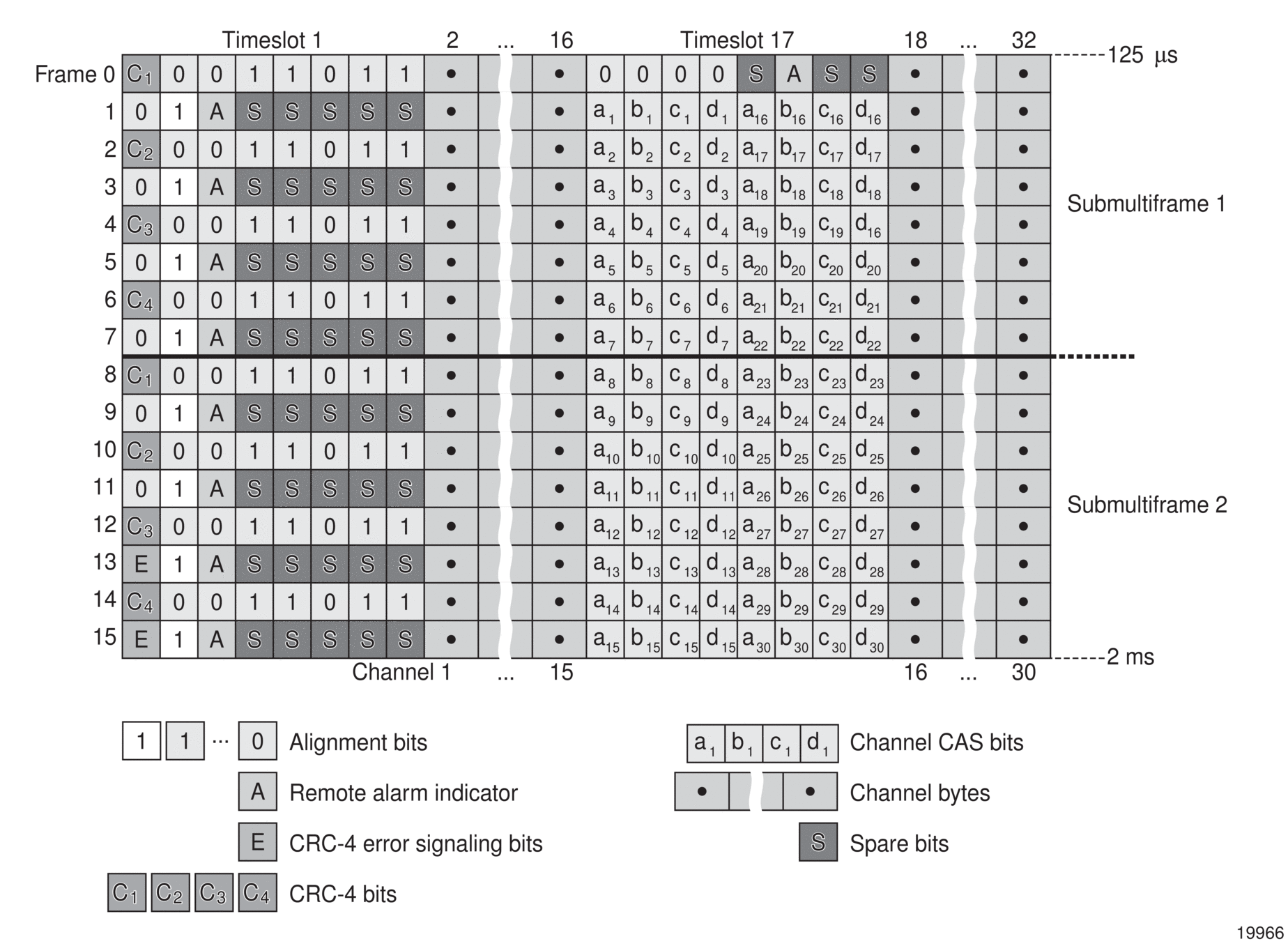
Table 32 describes the structure of a T1 ESF multi-frame that uses RBS. The structure of a T1 SF multi-frame is based on 12 frames and only the A and B bits are available.
Table 32: T1 Framing for CAS (RBS) Support in a T1 ESF Multiframe
Frame Number | F Bit | Bit Numbers in Each Channel Timeslot | Signaling Channel Designation 4 | ||||
Bit Number within Multiframe | Assignments | ||||||
FAS 1 | DL 2 | CRC 3 | For Character Signal 4 | For Signaling 4 | |||
1 | 1 | — | m | — | 1-8 | — | — |
2 | 194 | — | — | e1 | 1-8 | — | — |
3 | 387 | — | m | — | 1-8 | — | — |
4 | 580 | 0 | — | — | 1-8 | — | — |
5 | 773 | — | m | — | 1-8 | — | — |
6 | 966 | — | — | e2 | 1-7 | 8 | A |
7 | 1159 | — | m | — | 1-8 | — | — |
8 | 1352 | 0 | — | — | 1-8 | — | — |
9 | 1545 | — | m | — | 1-8 | — | — |
10 | 1738 | — | — | e3 | 1-8 | — | — |
11 | 1931 | — | m | — | 1-8 | — | — |
12 | 2124 | 1 | — | — | 1-7 | 8 | B |
13 | 2317 | — | m | — | 1-8 | — | — |
14 | 2510 | — | — | e4 | 1-8 | — | — |
15 | 2703 | — | m | — | 1-8 | — | — |
16 | 2896 | 0 | — | — | 1-8 | — | — |
17 | 3089 | — | m | — | 1-8 | — | — |
18 | 3282 | — | — | e5 | 1-7 | 8 | C |
19 | 3475 | — | m | — | 1-8 | — | — |
20 | 3668 | 1 | — | — | 1-8 | — | — |
21 | 3861 | — | m | — | 1-8 | — | — |
22 | 4054 | — | — | e6 | 1-8 | — | — |
23 | 4247 | — | m | — | 1-8 | — | — |
24 | 4440 | 1 | — | — | 1-7 | 8 | D |
- FAS = frame alignment signal (....001011.....)
- DL = 4 kb/s data link (m represents message bits)
- CRC = CRC-6 block check field (e1 to e6 represent check bits)
- Only applicable for CAS
Notes:
3.1.2.3. TDM Pseudowire Encapsulation
TDM circuits are MPLS-encapsulated as per RFC 4533 (SAToP) and RFC 5086 (CESoPSN), shown in Figure 16 and Figure 17.
Figure 16: SAToP MPLS Encapsulation
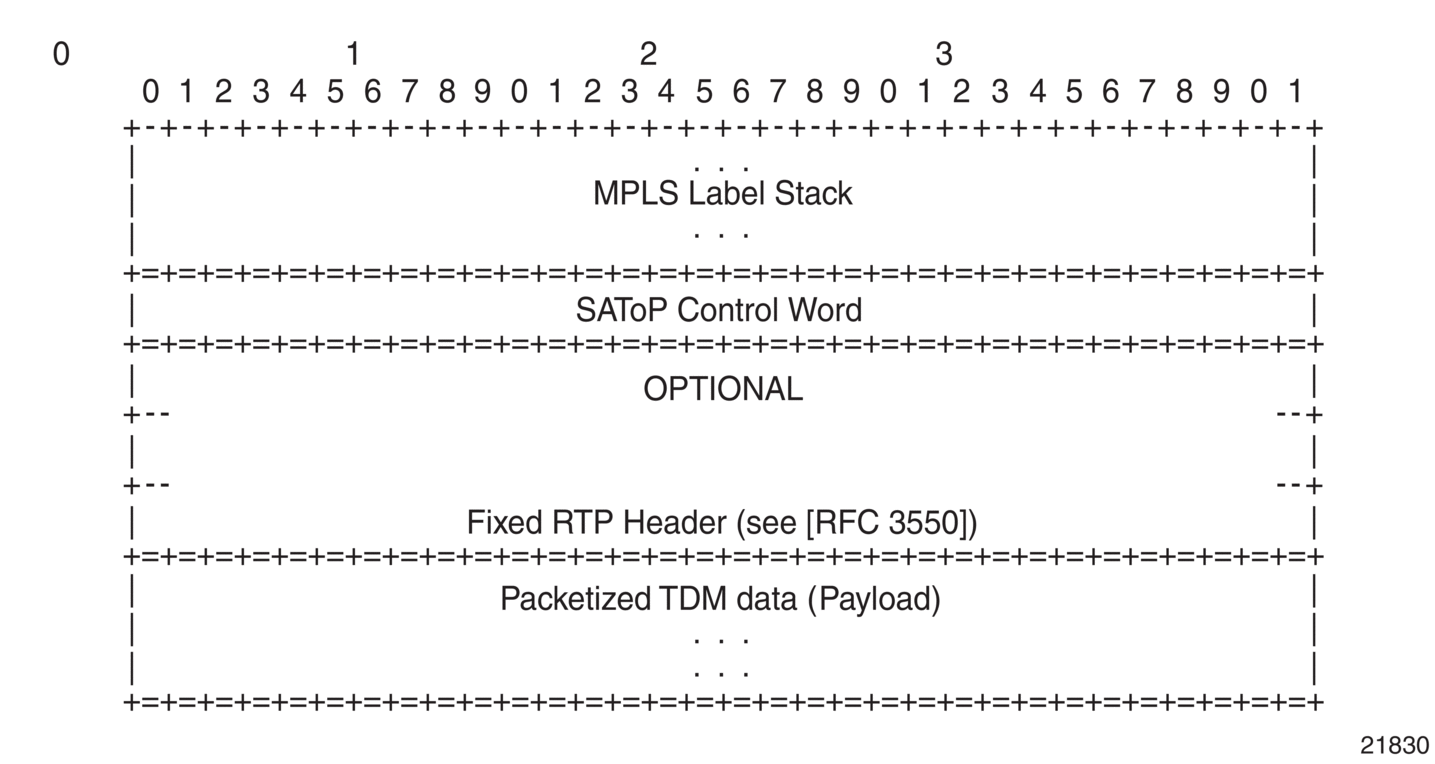
Figure 17: CESoPSN MPLS Encapsulation
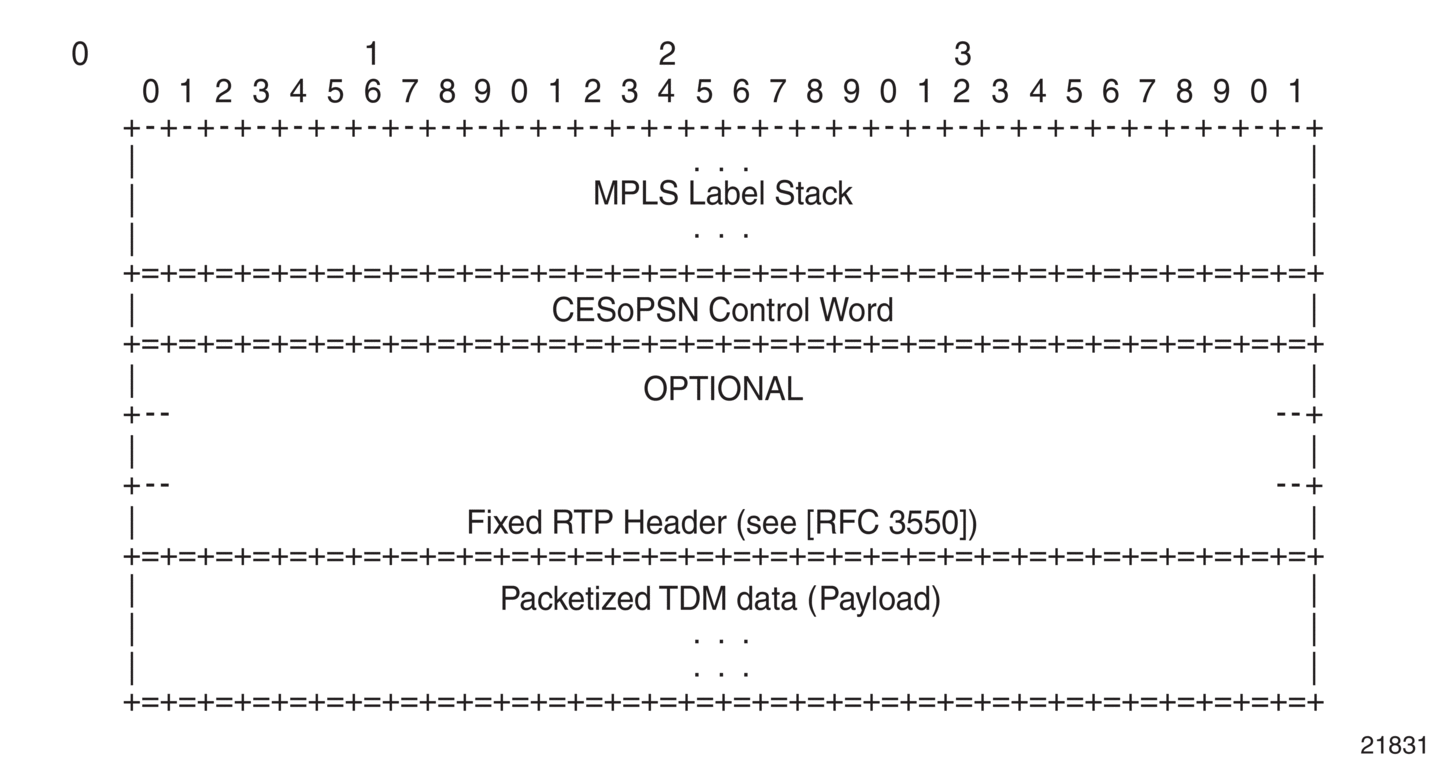
Figure 18 shows the format of the CESoPSN TDM payload (with and without CAS) for packets carrying trunk-specific 64 kb/s service. In CESoPSN, the payload size is dependent on the number of timeslots used.
Figure 18: CESoPSN Packet Payload Format for Trunk-Specific n x 64 kb/s (with and without CAS transport)
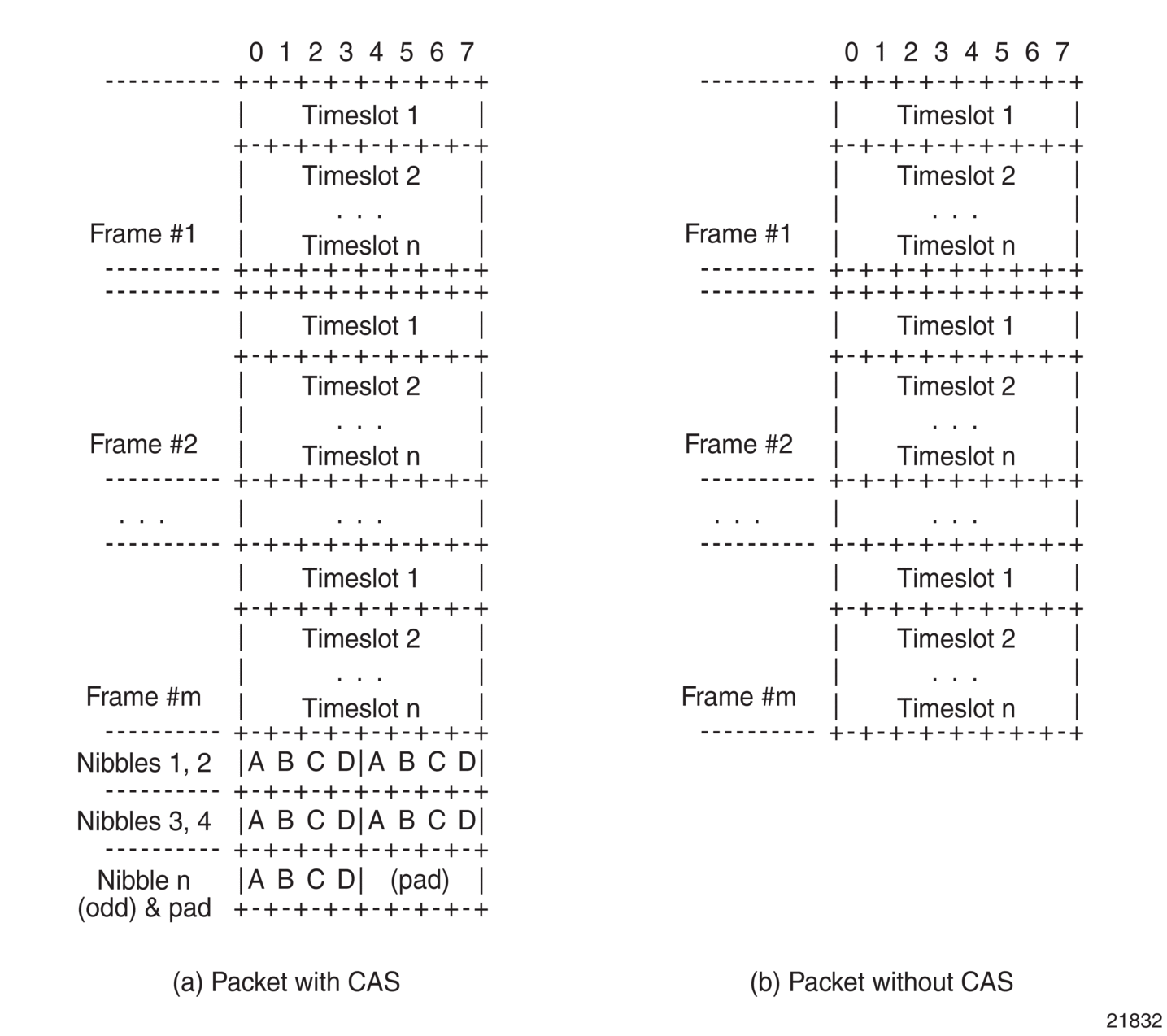
For CESoPSN without CAS, select the packet size so that an integer number of frames are transported. That is, if n timeslots per frame are to be encapsulated in a TDM PW, then the packet size must be a multiple of n (where n is not equal to 1). For example, if n = 4 timeslots, then the packet size can be 8, 12, 16 and so on.
For CESoPSN with CAS, the packet size is an integer number of frames, where the number of frames is 24 for T1 or 16 for E1, and is not user-configurable. The extra bytes for ABCD (CAS) signaling bits are not included when setting the packet size.
| Note: The extra bytes for CAS signaling bits must be included when setting the service-mtu size. |
3.1.2.4. Circuit Emulation Parameters and Options
All ports on the T1/E1 ASAP Adapter card can be configured independently to support TDM circuit emulation across the packet network. Structure-aware mode (CESoPSN) is supported for n × 64 kb/s channel groups in DS1 and E1 circuits. Unstructured mode (SAToP) is supported for full DS1 and E1 circuits. The following parameters and options are described in this section:
- Unstructured
- Structured DS1/E1 CES without CAS
- Structured T1/E1 CES with CAS
- Packet Payload Size
- Jitter Buffer
- RTP Header
- Control Word
3.1.2.4.1. Unstructured
Unstructured CES is configured by choosing satop-t1 or satop-e1 as the vc-type when creating a Cpipe service. For DS1 and E1 unstructured circuit emulation, the framing parameter of the port must be set to ds1-unframed and e1-unframed (respectively) because SAToP service ignores the underlying framing. Additionally, channel group 1 must contain all 24 or 32 timeslots, which is configured automatically when channel group 1 is created.
For DS1 and E1 circuit emulation, the payload packet size is configurable and must be an integer value between 64 and 1514 octets and must be a multiple of 32. The payload packet size affects the packet efficiency and packetization delay. Table 33 lists the default values for packet size and packetization delay.
Table 33: Unstructured Payload Defaults
Circuit | Payload Size (Octets) | Packetization Delay (milliseconds) |
DS1 | 192 | 1.00 |
E1 | 256 | 1.00 |
| Note: When using SAToP to transport DS1 traffic, the framing bit (bit 193) in the DS1 overhead is included and packed in the payload and sent over the PSN. If the underlying framing is ESF, then the Facility Data Link (FDL) channel is transported over the Cpipe as part of the SAToP service. No matter the case, the framing parameter of the port must be set to unframed. |
3.1.2.4.2. Structured DS1/E1 CES without CAS
Structured CES without CAS is configured by choosing cesopsn as the vc-type when creating a Cpipe service. For n * 64 kb/s structured circuit emulation operation, the framing parameter of the port must be set to a framed setting (such as ESF for DS1). Each channel group contains n DS0s (timeslots), where n is between 1 and 24 timeslots for DS1 and between 1 and 31 timeslots for E1.
The packet payload size is configurable (in octets) and must be an integer multiple of the number of timeslots in the channel group. The minimum payload packet size is 2 octets (based on two frames per packet and one timeslot per frame). See Table 34 for default and minimum payload size values. The maximum payload packet size is 1514 octets.
Each DS1 or E1 frame contributes a number of octets to the packet payload. That number is equal to the number of timeslots configured in the channel group. Therefore, a channel group with four timeslots contributes 4 octets to the payload. The timeslots do not need to be contiguous.
Note that a smaller packet size results in a lower packetization delay; however, it increases the packet overhead (when expressed as a percentage of the traffic).
3.1.2.4.2.1. Calculation of Payload Size
The payload size (S), in octets, can be calculated using the following formula:
S = N x F
Where:
N = the number of octets (timeslots) collected per received frame (DS1 or E1)
F = the number of received frames (DS1 or E1) that are accumulated in each CESoPSN packet.
For example, assume the packet collects 16 frames (F) and the channel group contains 4 octets (timeslots) (N). Then the packet payload size (S) is:
S = 4 octets/frame x 16 frames
= 64 octets
3.1.2.4.2.2. Calculation of Packetization Delay
Packetization delay is the time needed to collect the payload for a CESoPSN packet. DS1 and E1 frames arrive at a rate of 8000 frames per second. Therefore, the received frame arrival period is 125 µs.
In the previous example, 16 frames were accumulated in the CESoPSN packet. In this case, the packetization delay (D) can be calculated as follows:
D = 125 µs/frame * 16 frames
= 2.000 ms
Table 34 lists the default and minimum values for frames per packet, payload size, and packetization delay as they apply to the number of timeslots (N) that contribute to the packet payload. The default values are set by the operating system as follows:
- For N = 1, the default is 64 frames/packet
- For 2 ≤ N ≤ 4, the default is 32 frames/packet
- For 5 ≤ N ≤ 15, the default is 16 frames/packet
- For N ≥ 16, the default is 8 frames/packet
Table 34: Default and Minimum Payload Size for CESoPSN without CAS
Number of Timeslots (N) | Default Values | Minimum Values | ||||
Frames per Packet (F) | Payload Size (Octets) (S) | Packetization Delay (ms) (D) | Frames per Packet (F) | Payload Size (Octets) (S) | Packetization Delay (ms) (D) | |
1 | 64 | 64 | 8.000 | 2 | 2 | 0.250 |
2 | 32 | 64 | 4.000 | 2 | 4 | 0.250 |
3 | 32 | 96 | 4.000 | 2 | 6 | 0.250 |
4 | 32 | 128 | 4.000 | 2 | 8 | 0.250 |
5 | 16 | 80 | 2.000 | 2 | 10 | 0.250 |
6 | 16 | 96 | 2.000 | 2 | 12 | 0.250 |
7 | 16 | 112 | 2.000 | 2 | 14 | 0.250 |
8 | 16 | 128 | 2.000 | 2 | 16 | 0.250 |
9 | 16 | 144 | 2.000 | 2 | 18 | 0.250 |
10 | 16 | 160 | 2.000 | 2 | 20 | 0.250 |
11 | 16 | 176 | 2.000 | 2 | 22 | 0.250 |
12 | 16 | 192 | 2.000 | 2 | 24 | 0.250 |
13 | 16 | 208 | 2.000 | 2 | 26 | 0.250 |
14 | 16 | 224 | 2.000 | 2 | 28 | 0.250 |
15 | 16 | 240 | 2.000 | 2 | 30 | 0.250 |
16 | 8 | 128 | 1.000 | 2 | 32 | 0.250 |
17 | 8 | 136 | 1.000 | 2 | 34 | 0.250 |
18 | 8 | 144 | 1.000 | 2 | 36 | 0.250 |
19 | 8 | 152 | 1.000 | 2 | 38 | 0.250 |
20 | 8 | 160 | 1.000 | 2 | 40 | 0.250 |
21 | 8 | 168 | 1.000 | 2 | 42 | 0.250 |
22 | 8 | 176 | 1.000 | 2 | 44 | 0.250 |
23 | 8 | 184 | 1.000 | 2 | 46 | 0.250 |
24 | 8 | 192 | 1.000 | 2 | 48 | 0.250 |
25 | 8 | 200 | 1.000 | 2 | 50 | 0.250 |
26 | 8 | 208 | 1.000 | 2 | 52 | 0.250 |
27 | 8 | 216 | 1.000 | 2 | 54 | 0.250 |
28 | 8 | 224 | 1.000 | 2 | 56 | 0.250 |
29 | 8 | 232 | 1.000 | 2 | 58 | 0.250 |
30 | 8 | 240 | 1.000 | 2 | 60 | 0.250 |
31 | 8 | 248 | 1.000 | 2 | 62 | 0.250 |
3.1.2.4.3. Structured T1/E1 CES with CAS
Structured circuit emulation with CAS is supported for T1 and E1 circuits.
Structured CES with CAS service is configured by selecting cesopsn-cas as the vc-type when creating a Cpipe service. The DS1 or E1 service on the port associated with the Cpipe SAP should be configured to support CAS (using the signal-mode {cas} command) before configuring the Cpipe service to support DS1 or E1 with CAS. See the 7210 SAS-M, T, R6, R12, Mxp, Sx, S Interface Configuration Guide for information about configuring signal mode.
For n *64 kb/s structured circuit emulation with CAS, the implementation is almost identical to that of CES without CAS. When CAS operation is enabled, timeslot 16 cannot be included in the channel group on E1 carriers. The CAS option is enabled or disabled at the port level; therefore, it applies to all channel groups on that E1 port.
The packet size is based on 16 frames per packet for E1 when CAS is enabled and is not user-configurable. For example, if the number of timeslots is 4, then the payload size is 64 octets. This 16-frame fixed configuration is logical because an E1 multi-frame contains 16 frames; therefore, correct bit positioning for the A, B, C, and D CAS signaling bits can be ensured at each end of the pseudo wire.
Table 35 lists the payload sizes based on the number of timeslots.
For CAS, the signaling portion adds (n/2) bytes (n is an even integer) or ((n+1)/2) bytes (n is odd) to the packet, where n is the number of timeslots in the channel group. Note that you do not include the additional signaling bytes in the configuration setting of the TDM payload size. However, the operating system includes the additional bytes in the total packet payload, and the total payload must be accounted for when setting the service-mtu size. Continuing the preceding example, since n = 4, the total payload is 64 octets plus (4/2 = 2) CAS octets, or 66 octets. See Figure 18 to view the structure of the CES with CAS payload.
CES fragmentation is not supported.
| Note: If you configure the service-mtu size to be smaller than the total payload size (payload plus CAS bytes), then the Cpipe will not become operational. This must be considered if you change the service-mtu from its default value. |
Table 35 lists default values for the payload size for T1 and E1 CESoPSN with CAS.
Table 35: Default Values for the Payload Size for T1 and E1 CESoPSN with CAS
Number of Timeslots | T1 | E1 | ||||
Number of Frames per Packet | Payload Size (Octets) | Packetization Delay (ms) | Number of Frames per Packet | Payload Size (Octets) | Packetization Delay (ms) | |
1 | 24 | 24 | 3.00 | 16 | 16 | 2.00 |
2 | 24 | 48 | 3.00 | 16 | 32 | 2.00 |
3 | 24 | 72 | 3.00 | 16 | 48 | 2.00 |
4 | 24 | 96 | 3.00 | 16 | 64 | 2.00 |
5 | 24 | 120 | 3.00 | 16 | 80 | 2.00 |
6 | 24 | 144 | 3.00 | 16 | 96 | 2.00 |
7 | 24 | 168 | 3.00 | 16 | 112 | 2.00 |
8 | 24 | 192 | 3.00 | 16 | 128 | 2.00 |
9 | 24 | 216 | 3.00 | 16 | 144 | 2.00 |
10 | 24 | 240 | 3.00 | 16 | 160 | 2.00 |
11 | 24 | 264 | 3.00 | 16 | 176 | 2.00 |
12 | 24 | 288 | 3.00 | 16 | 192 | 2.00 |
13 | 24 | 312 | 3.00 | 16 | 208 | 2.00 |
14 | 24 | 336 | 3.00 | 16 | 224 | 2.00 |
15 | 24 | 360 | 3.00 | 16 | 240 | 2.00 |
16 | 24 | 384 | 3.00 | 16 | 256 | 2.00 |
17 | 24 | 408 | 3.00 | 16 | 272 | 2.00 |
18 | 24 | 432 | 3.00 | 16 | 288 | 2.00 |
19 | 24 | 456 | 3.00 | 16 | 304 | 2.00 |
20 | 24 | 480 | 3.00 | 16 | 320 | 2.00 |
21 | 24 | 504 | 3.00 | 16 | 336 | 2.00 |
22 | 24 | 528 | 3.00 | 16 | 352 | 2.00 |
23 | 24 | 552 | 3.00 | 16 | 368 | 2.00 |
24 | 24 | 576 | 3.00 | 16 | 384 | 2.00 |
25 | NA | NA | NA | 16 | 400 | 2.00 |
26 | NA | NA | NA | 16 | 416 | 2.00 |
27 | NA | NA | NA | 16 | 432 | 2.00 |
28 | NA | NA | NA | 16 | 448 | 2.00 |
29 | NA | NA | NA | 16 | 464 | 2.00 |
30 | NA | NA | NA | 16 | 480 | 2.00 |
3.1.2.4.4. Packet Payload Size
The packet payload size defines the number of octets contained in the payload of a TDM pseudowire packet when the packet is transmitted. Each DS0 (timeslot) in a DS1 or E1 frame contributes 1 octet to the payload, and the total number of octets contributed per frame depends on the number of timeslots in the channel group (for example, 10 timeslots contribute 10 octets per frame).
3.1.2.4.5. Jitter Buffer
A circuit emulation service uses a jitter buffer to ensure that received packets are tolerant to packet delay variation (PDV). The selection of jitter buffer size must take into account the size of the TDM-encapsulated packets (payload size). A correctly configured jitter buffer provides continuous play-out, thereby avoiding discards due to overruns and under runs (packets arriving too early or too late). The maximum receive jitter buffer size is configurable for each SAP configured for circuit emulation. The range of values is from 1 to 250 ms in increments of 1 ms.
3.1.2.4.5.1. Configuration or Design Considerations
Determining the best configuration value for the jitter buffer may require some adjustments to account for the requirements of your network, which can change PDV as nodes are added or removed.
The buffer size must be set to at least three times the packetization delay and no greater than 32 times the packetization delay. Use a buffer size (in ms) that is equal to or greater than the peak-to-peak packet delay variation (PDV) expected in the network used by circuit emulation service. For example, for a PDV of ±5 ms, configure the jitter buffer to be at least 10 ms.
| Note: The jitter buffer setting and payload size (packetization delay) interact such that it may be necessary for the operating system to adjust the jitter buffer setting to ensure no loss of packets. Therefore, the configured jitter buffer value may not be the value used by the system. Use the show>service>id service_id>all command to show the effective PDVT (packet delay variation tolerance). |
The following values are the default jitter buffer times for structured circuits, where N is the number of timeslots:
- For N = 1, the default is 32 ms
- For 2 ≤ N ≤ 4, the default is 16 ms
- For 5 ≤ N ≤ 15, the default is 8 ms
- For N ≥ 16, the default is 5 ms
Jitter buffer overrun and under run counters are available for statistics and can raise an alarm (optional) while the circuit is operational. For overruns, excess packets are discarded and counted. For under runs, an all-ones pattern is sent for unstructured circuits and an all-ones or a user-defined pattern is sent for structured circuits (based on configuration).
The circuit status and statistics can be displayed using the appropriate show command.
3.1.2.4.6. RTP Header
For all circuit emulation channels, the RTP in the header is optional (as per RFC 5086).
When enabled for absolute mode operation, an RTP header is inserted in the MPLS frame upon transmit. Absolute mode is defined in RFC 5086 and means that the ingress PE will set timestamps using the clock recovered from the incoming TDM circuit. When an MPLS frame is received, the RTP header is ignored. The RTP header mode is for TDM pseudowire interoperability purposes only and should be enabled when the other device requires an RTP header.
3.1.2.4.7. Control Word
The structure of the control word is mandatory for SAToP and is shown in Figure 19.
Figure 19: Control Word Bit Structure

The control word descriptions are listed in Table 36.
Table 36: Control Word Bit Description
Bit(s) | Description |
Bits 0 to 3 | The use of bits 0 to 3 is described in RFC 4385. These bits are set to ‘0’ unless they are being used to indicate the start of an Associated Channel Header (ACH) for the purposes of VCCV. |
L (Local TDM Failure) | The L bit is set to 1 if an abnormal condition of the attachment circuit such as LOS, LOF, or AIS has been detected and the TDM data carried in the payload is invalid. The L bit is cleared (set back to 0) when fault is rectified. |
R (Remote Loss of Frames indication) | The R bit is set to 1 if the local CE-bound inter-working function (IWF) is in the packet loss state and cleared (reset to 0) after the local CE-bound IWF is no longer in the packet loss state. |
M (Modifier) | The M bits are a 2-bit modifier field. For SAToP, M is set to 00 as per RFC 4553. |
Sequence number | The sequence number is used to provide the common pseudowire sequencing function as well as detection of lost packets. |
3.1.2.4.8. Error Situations
The CE-bound inter-working function (IWF) uses the sequence numbers in the control word to detect lost and incorrectly ordered packets. Incorrectly ordered packets that cannot be re-ordered are discarded.
For unstructured CES, the payload of received packets with the L bit set is replaced with an all-ones pattern. For structured CES, the payload of received packets with the L bit set is replaced with an all-ones or a user-configurable bit pattern. This is configured using the idle-payload-fill command. For structured CES with CAS, the signaling bits are replaced with an all-ones or a user-configurable bit pattern. This is configured using the idle-signal-fill command. See the 7210 SAS-M, T, R6, R12, Mxp, Sx, S Interface Configuration Guide more information. All circuit emulation services can have a status of up, loss of packets (LOP) or admin down, and any jitter buffer overruns or under runs are logged.
3.2. Ethernet Pipe (Epipe) Services
This section provides information about the Epipe service and implementation notes.
3.2.1. Epipe Service Overview
An Epipe service is a Layer 2 point-to-point service where the customer data is encapsulated and transported across a service provider network. An Epipe service is completely transparent to the subscriber data and protocols. The Epipe service does not perform any MAC learning. A local Epipe service consists of two SAPs on the same node, whereas a distributed Epipe service consists of two SAPs on different nodes.
Each SAP configuration includes a specific port on which service traffic enters the 7210 SAS router from the customer side (also called the access side). Each port is configured with an encapsulation type. If a port is configured with an IEEE 802.1Q (referred to as Dot1q) encapsulation, then a unique encapsulation value (ID) must be specified.
Figure 20 shows Epipe/VLL customer service.
Figure 20: Epipe/VLL Service
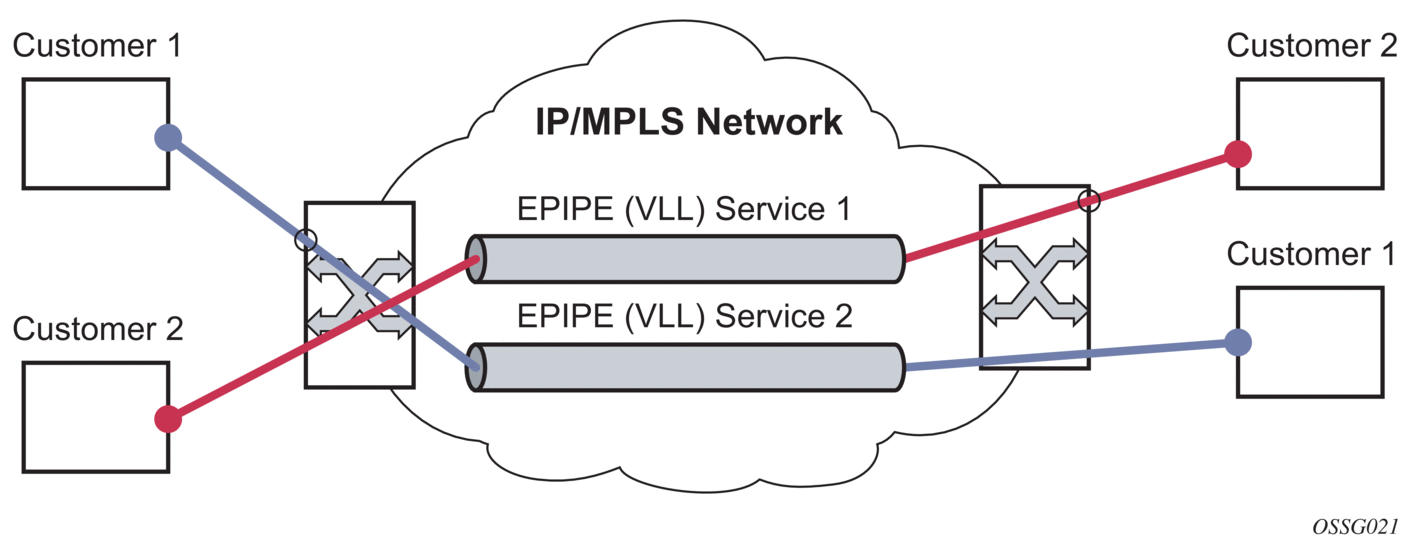
3.2.2. Epipe with PBB
| Note: Epipes with PBB is only supported on 7210 SAS-M and 7210 SAS-T operating in the network mode. |
A pbb-tunnel may be linked to an Epipe to a B-VPLS. MAC switching and learning is not required for the point-to-point service (all packets ingressing the SAP are PBB encapsulated and forwarded to the PBB tunnel to the backbone destination MAC address and all the packets ingressing the B-VPLS destined for the ISID are PBB de-encapsulated and forwarded to the Epipe SAP. A fully specified backbone destination address must be provisioned for each PBB Epipe instance to be used for each incoming frame on the related I-SAP. If the backbone destination address is not found in the B-VPLS FDB then packets may be flooded through the B-VPLSes
All B-VPLS constructs may be used including B-VPLS resiliency and OAM. Not all generic Epipe commands are applicable when using a PBB tunnel.
3.2.3. Support for Processing of Packets Received with More Than 2 Tags on a QinQ SAP in Epipe Service
| Note: This section applies to all 7210 SAS platforms as described in this document, except those operating in access-uplink mode. 7210 SAS platforms operating in access-uplink mode can process and forward packets with more than two tags. See Configuration Notes for restrictions on the use of SAPs by platforms operating in access-uplink mode. |
To forward packets with 2 or more tags using a QinQ SAP, a new Epipe service type is available for use when 7210 SAS devices are operating in ‘network’ mode. This new service will allow for configuration of a QinQ SAP as one endpoint and the following service entities as the other endpoint:
- MPLS spoke-SDP with vc-type set to vc-vlan.
- The vc-vlan-tag to be must match the inner-tag VLAN ID value specified in the QinQ SAP.
- dot1q SAP
- The VLAN value configured for the dot1q SAP must match the inner-tag VLAN ID value of the QinQ SAP.
- QinQ SAP
- The inner VLAN tag of both QinQ SAPs configured in the service must be the same.
The device will process the packet as listed as follows in the forward direction:
- If the packet is received on a QinQ SAP, assign an incoming packet to this service based on matching the outermost two tags in the packet header (i.e. that is the first two tags in the packet header). It will strip only the outermost tag (only a single tag) on ingress and forward the rest on to the other endpoint in the service.
- If the other endpoint the packet is sent out of is a MPLS SDP, then MPLS encapsulation is added.
- If the other endpoint the packet is sent out of is a dot1q SAP packet is forwarded as is, without any egress VLAN checks. It is expected that operator will ensure that the inner tag of the packet matches the dot1q VLAN value.
- If the other endpoint the packet is sent out of is another QinQ SAP (for example, Q1.Q2 SAP), then another tag (that is, Q2 tag) is added to the packet and sent out of the QinQ SAP.
In the reverse direction, the device will process the packet as listed as follows:
- When traffic is received on the MPLS SDP, the vc-vlan tag is retained as is and the VLAN tag corresponding to the outermost tag configured for the QinQ SAP (i.e. the other endpoint) is added to the packet. The system does not match the vc-vlan tag received in the packet with the configured value (i.e. the inner tag of the QinQ SAP). It is expected that operator will configure both end of the service appropriately to ensure only appropriate packets enter the service.
- When traffic is received on the dot1q SAP, the outermost tag is not stripped and the VLAN tag corresponding to the outermost tag configured for the QinQ SAP is added to the packet.
- If the packet is received on a QinQ SAP, assign an incoming packet to this service based on matching the outermost two tags in the packet header (that is, that is the first two tags in the packet header). It will strip only the outermost tag (only a single tag) on ingress. The VLAN tag corresponding to the outermost tag configured for the QinQ SAP (that is, the other endpoint) is added to the packet and it is sent out of the QinQ SAP.
Therefore, the device processes packets received with 2 or more tags using the MPLS SDP or a dot1q SAP while classifying on the QinQ SAP ingress using 2 tags.
3.2.3.1. Feature Support, Configuration Notes and Restrictions
A svc-sap-type value "qinq-inner-tag-preserve" is available for configuring the service. This must be used when creating a new Epipe service if this functionality is desired (For example: epipe 10 svc-sap-type qinq-inner-tag-preserve create).
- This service is available only in network mode.
- Epipe service created with the parameter svc-sap-type set to qinq-inner-tag-preserve will allow for only one QinQ SAP and only one SDP of vc-type ‘vc-vlan’. The system will not allow the user to use any other SAP in this new service, that is, NULL SAP, Q1. * SAP, 0.* SAP, etc, are not allowed for configuration in this service. The SDP cannot be of vc-type ‘vc-ether’.
- User can configure vlan-vc-tag value for the SDP, the dot1q SAP VLAN tag value and the inner tag VLAN value of a QinQ SAP to match the VLAN ID value of the inner tag specified in the Q1.Q2 SAP configured in the service (example: if the SAP is 1/1/10:Q1.Q2, then vlan-vc-tag must be set to Q2, the dot1q SAP VLAN value must be Q2, and the inner tag of another QinQ SAP must be set to Q2). If any other value, other than QinQ SAP's inner tag is configured for vlan-vc-tag or dot1q SAP VLAN value, or for the inner tag of the QinQ SAP then it will be errored out by the software. If vlan-vc-tag value is not configured, it defaults to use the inner VLAN tag value. It is highly recommended that the customer configure the vlan-vc-tag value to match the VLAN ID value of the inner tag configured for the QinQ SAP, to avoid mis-configuration.
- Existing QoS and ACL functionality for the Epipe service entities will continue to be available, with the following exceptions:
- If the packet is received with more than 2 tags, then IP match-criteria cannot be used with SAP ingress QoS classification and ACLs (both Ingress and Egress ACLs).
- If the packet is received with more than 2 tags, then Ethertype value in the mac-criteria cannot be used with SAP ingress QoS classification and ACLs (both Ingress and Egress ACLs).
- Dot1p bits from the outermost tag (i.e. Q1 VLAN tag, if the SAP is 1/1/10:Q1.Q2) will be used for SAP ingress classification. Dot1p bits of the outermost tag will be marked on egress, if marking is enabled on the egress port. The Dot1p bit value of the vc-vlan-tag is not used to mark the Dot1p bits of the outermost VLAN tag, when the packets is exiting the QinQ SAP.
- OAM tools
- MPLS OAM tools such as vccv-ping, vccv-trace, etc. is supported for the SDPs
- Accounting and Statistics for the service entities (e.g. SAP and SDP) will be available as before
- CFM/Y.1731 tools are supported. UP and Down MEP is supported on the SAPs and the SDPs configured in the Epipe service.
- Following Redundancy mechanisms available in Epipe service is supported when using MPLS SDP:
- Epipe PW redundancy
- MC-LAG based protection for access SAPs using the new service type (along with use PW redundancy)
3.2.3.2. Configuration Example of Epipe Services for Processing of Packets Received with More Than 2 Tags on a QinQ SAP
The following is a sample output of when the user configures “vlan-vc-tag” value to match the inner tag specified in the Q1.Q2 SAP configured in the service.
The following is a sample output of an Epipe service with QinQ SAP and dot1q SAP. In the following sample, note that the Dot1q SAP's (1/1/4:45) VLAN value '45', matches the inner tag VLAN value specified with QinQ SAP (1/1/3:10.45).
The following is a sample output of an Epipe service with 2 QinQ SAPs. In the following sample, note that the inner tag of both QinQ SAPs matches and is set to a value of '45'.
3.2.4. Epipe Operational State Decoupling
An Epipe service transitions to an operation state, ‘Down’ when only a single entity SAP or Binding is active and the operation state of the mate is down or displays an equivalent state. The default behavior does not allow operators to validate the connectivity and measure performance metrics. With this feature an option is provided to allow operators to validate the connectivity and measure performance metrics of an Epipe service before the customer handoff. The operator can also maintain performance and continuity measurement across their network regardless of the connectivity between the terminating node and the customer. If the SAP between the operator and the customer enters a Oper Down state, the Epipe remains Operationally UP, so the results can continue to be collected uninterrupted. The operator receives applicable port or SAP alerts/alarms. This option is available only for the customer facing SAP failures. If a network facing SAP or Spoke-SDP fails the operational state of the Epipe service is set to 'Down'. That is, there is no option to hold the service in an UP state, if a network component fails.
The following functionality is supported:
- Configuration under SAP is required to change the default behavior of the Epipe service in response to the SAP failure.
- The user can create a SAP on a LAG where the LAG has no port members. In this case, the operator configures the “ignore-oper-state” on the SAP and the service remains operational. However, as there are no ports existing in the LAG member group, there is no extraction function that can be created. This feature protects against an established working configuration with full forwarding capabilities from failing to collect PM data. The user should shutdown their equipment and place the Epipe SAP in an operationally down state.
- The SAP connecting the provider equipment to the customer is configured to hold the Epipe service status UP when the customer facing SAP enters any failed state. Only one SAP per Epipe is allowed to be configured.
- Any failure of the network entity (network SAP or SDP-Binding) still cause the Epipe service to transition to OPER=DOWN.
- As the service remains operationally up, all bindings should remain operationally up and should be able to receive and transmit data. The PW status represents the failed SAP in the LDP status message, but this does not prevent the data from using the PW as a transport, in or out. This is the same as LDP status messaging.
- The SAP failure continues to trigger normal reactions, except the operational state of the service
- ETH-CFM PM measurement tools (DMM/SLM) can be used with the UP MEP on the failed SAP to collect performance metric. Additionally, CFM troubleshooting tools & connectivity (LBM, LTM, AIS, CCM) can be used and will function .
- ETH-CFM CCM processing and fault propagation does not change. Even when a SAP fails with the hold service UP configuration, CCM sets the Interface Status TLV to “Down”.
- VPLS services remain operationally UP until the final entity in the service enters a failed operational state. There are no changes to VPLS services and the change is specific to Epipe.
3.3. Pseudowire Switching
| Note: 7210 SAS-M and 7210 SAS-T can be configured only as T-PE nodes. 7210 SAS-Mxp, 7210 SAS-Sx/S 1/10GE, and 7210 SAS-Sx 10/100GE can be configured as either T-PE or S-PE nodes. |
The pseudowire switching feature provides the user with the ability to create a VLL service by cross-connecting two spoke-SDPs. This feature allows the scaling of VLL and VPLS services in a large network in which the otherwise full mesh of PE devices would require thousands of Targeted LDP (T-LDP) sessions per PE node.
Services with one SAP and one spoke-SDP are created usually on the PE; however, the target destination of the SDP is the pseudowire switching node instead of what is usually the remote PE.
The pseudowire switching node acts in a passive role with respect to signaling of the pseudowires. It waits until one or both of the PEs sends the label mapping message before relaying it to the other PE. This is because it needs to pass the Interface Parameters of each PE to the other.
A pseudowire switching point TLV is inserted by the switching pseudowire to record its system address when relaying the label mapping message. This TLV is useful in a few situations:
- It allows for troubleshooting of the path of the pseudowire especially if multiple pseudowire switching points exist between the two PEs.
- It helps in loop detection of the T-LDP signaling messages where a switching point would receive back a label mapping message it had already relayed.
- The switching point TLV is inserted in pseudowire status notification messages when they are sent end-to-end or from a pseudowire switching node toward a destination PE.
Pseudowire OAM is supported for the manual switching pseudowires and allows the pseudowire switching node to relay end-to-end pseudowire status notification messages between the two PEs. The pseudowire switching node can generate a pseudowire status and to send it to one or both of the PEs by including its system address in the pseudowire switching point TLV. This allows a PE to identify the origin of the pseudowire status notification message.
In the following pseudowire service switching node example, the user configures a regular Epipe VLL service PE1 and PE2. These services consist each of a SAP and a spoke SPD. However, the target destination of the SDP is actually not the remote PE but the pseudowire switching node. In addition, the user configures an Epipe VLL service on the pseudowire switching node using the two SDPs.
3.3.1. Pseudowire Switching with Protection
Pseudowire switching scales VLL and VPLS services over a multi-area network by removing the need for a full mesh of targeted LDP sessions between PE nodes. Figure 21 shows the use of pseudowire redundancy to provide a scalable and resilient VLL service across multiple IGP areas in a provider network.
Figure 21: VLL Resilience with Pseudowire Redundancy and Switching
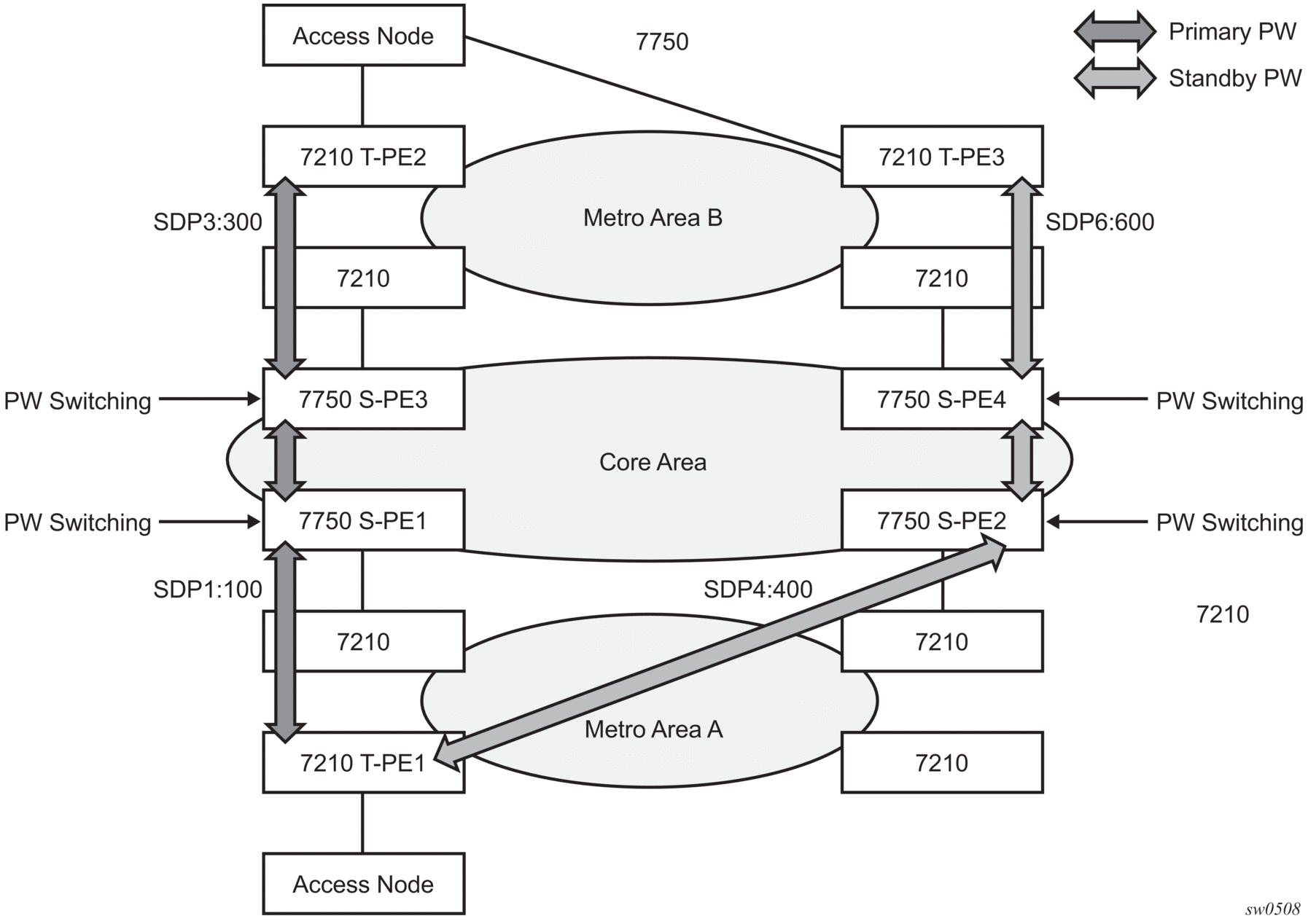
In the network in Figure 21, PE nodes act as masters and pseudowire switching nodes act as slaves for the purpose of pseudowire signaling. A switching node will need to pass the SAP Interface Parameters of each PE to the other.T-PE1 sends a label mapping message for the Layer 2 FEC to the peer pseudowire switching node” for example, S-PE1. It will include the SAP interface parameters, such as MTU, in the label mapping message. S-PE1 checks the FEC against the local information and if a match exists, it appends the optional pseudowire switching point TLV to the FEC TLV in which it records its system address. T-PE1 then relays the label mapping message to S-PE2. S-PE2 performs similar operations and forwards a label mapping message to T-PE2. The same procedures are followed for the label mapping message in the reverse direction, for example, from T-PE2 to T-PE1. S-PE1 and S-PE2 will effect the spoke-SDP cross-connect only when both directions of the pseudowire have been signaled and matched.
The pseudowire switching TLV is useful in a few situations. First, it allows for troubleshooting of the path of the pseudowire especially if multiple pseudowire switching points exist between the two T-PE nodes. Secondly, it helps in loop detection of the T-LDP signaling messages where a switching point receives back a label mapping message it already relayed. Finally, it can be inserted in pseudowire status messages when they are sent from a pseudowire switching node toward a destination PE.
Pseudowire status messages can be generated by the T-PE nodes. Pseudowire status messages received by a switching node are processed and then passed on to the next hop. An S-PE node appends the optional pseudowire switching TLV, with its system address added to it, to the FEC in the pseudowire status notification message only if it originated the message or the message was received with the TLV in it. Otherwise, it means the message was originated by a T-PE node and the S-PE should process and pass the message without changes except for the VCID value in the FEC TLV.
3.3.2. Pseudowire Switching Behavior
In the network in Figure 21, PE nodes act as masters and pseudowire switching nodes act as slaves for the purpose of pseudowire signaling. This is because a switching node will need to pass the SAP interface parameters of each PE to the other.T-PE1 sends a label mapping message for the Layer 2 FEC to the peer pseudowire switching node, for example, S-PE1. It will include the SAP interface parameters, such as MTU, in the label mapping message. S-PE1 checks the FEC against the local information and if a match exists, it appends the optional pseudowire switching point TLV to the FEC TLV in which it records its system address. T-PE1 then relays the label mapping message to S-PE2. S-PE2 performs similar operation and forwards a label mapping message to T-PE2. The same procedures are followed for the label mapping message in the reverse direction, for example, from T-PE2 to T-PE1. S-PE1 and S-PE2 will effect the spoke-SDP cross-connect only when both directions of the pseudowire have been signaled and matched.
The merging of the received T-LDP status notification message and the local status for the spoke-SDPs from the service manager at a PE complies with the following rules:
- When the local status for both spokes is up, the S-PE passes any received SAP or SDP-binding generated status notification message unchanged, for example, the status notification TLV is unchanged but the VC-ID in the FEC TLV is set to value of the pseudowire segment to the next hop.
- When the local operational status for any of the spokes is down, the S-PE always sends SDP-binding down status bits regardless if the received status bits from the remote node indicated SAP up/down or SDP-binding up/down.
3.3.2.1. Pseudowire Switching TLV
Figure 22 shows the format of the pseudowire switching TLV.
Figure 22: Pseudowire Switching TLV Format
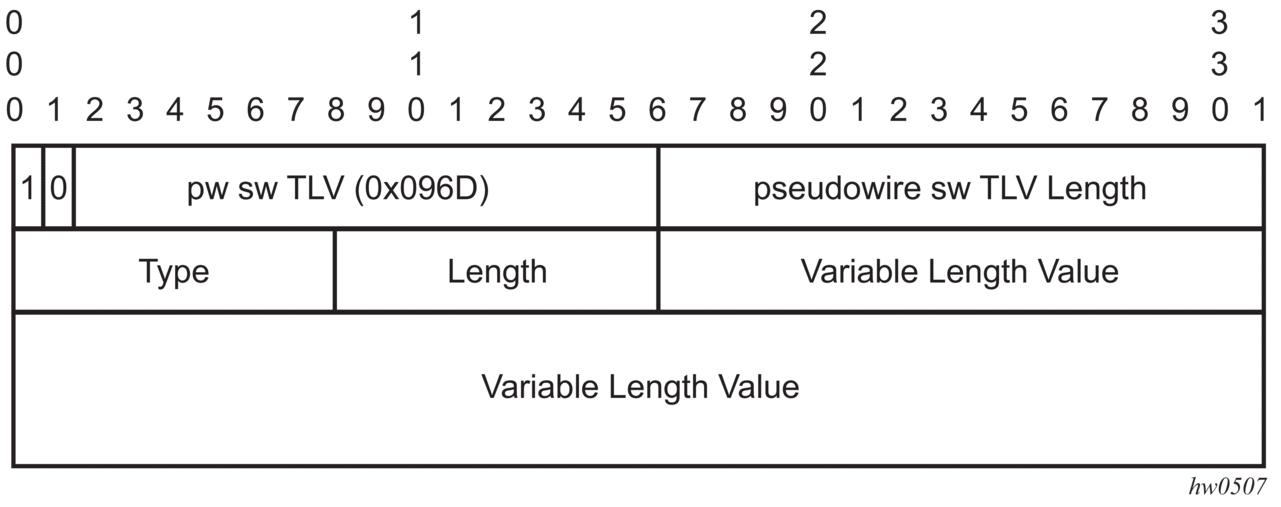
- PW sw TLV LengthThis field specifies the total length of all the following pseudowire switching point TLV fields in octets.
- TypeThis field encodes how the Value field is interpreted.
- LengthThis field specifies the length of the Value field in octets.
- ValueThe Octet string of Length octets encodes information to be interpreted as specified by the Type field.
The format of the pseudowire switching point sub-TLVs is as follows:
- pseudowire ID of last pseudowire segment traversedThis sub-TLV type contains a pseudowire ID in the format of the pseudowire ID.
- pseudowire switching point description stringThis is an optional description text string up to 80 characters.
- IP address of pseudowire switching point
- IPv4 or IPv6 address of pseudowire switching pointThis is an optional sub-TLV.
- MH VCCV capability indication
3.3.2.2. Static-to-Dynamic Pseudowire Switching
When one segment of the pseudowire cross-connect at the S-PE is static while the other is signaled using T-LDP, the S-PE operates much like a T-PE from a signaling perspective and as an S-PE from a data plane perspective.
The S-PE signals a label mapping message as soon as the local configuration is complete. The control word C-bit field in the pseudowire FEC is set to the value configured on the static spoke-SDP.
When the label mapping for the egress direction is also received from the T-LDP peer, and the information in the FEC matches that of the local configuration, the static-to-dynamic cross-connect is effected.
Note that it is possible that end nodes of a static pseudowire segment be misconfigured. In this case, an S-PE or T-PE node may be receiving packets with the wrong encapsulation. In this case, it is possible that an invalid payload will be forwarded over the pseudowire or the SAP respectively. Also, if the S-PE or T-PE node is expecting the control word in the packet encapsulation and the received packet comes with no control word but the first nibble below the label stack is 0x0001, the packet may be mistaken for a VCCV OAM packet and may be forwarded to the CPM. In that case, the CPM will perform a check of the IP header fields such as version, IP header length, and checksum. If any of this fails the VCCV packet will be discarded.
3.3.3. Pseudowire Redundancy
Pseudowire redundancy provides the ability to protect a pseudowire with a preprovisioned pseudowire and to switch traffic over to the secondary standby pseudowire in case of a SAP and/or network failure condition. Usually, pseudowires are redundant by the virtue of the SDP redundancy mechanism. For instance, if the SDP is an RSVP LSP and is protected by a secondary standby path and/or by Fast-Reroute paths, the pseudowire is also protected. However, there are a couple of applications in which SDP redundancy does not protect the end-to-end pseudowire path:
- There are two different destination PE nodes for the same VLL service. The main use case is the provision of dual-homing of a CPE or access node to two PE nodes located in different POPs. The other use case is the provision of a pair of active and standby BRAS nodes, or active and standby links to the same BRAS node, to provide service resiliency to broadband service subscribers.
- The pseudowire path is switched in the middle of the network and the 7210 SAS pseudowire switching node fails.
Pseudowire and VPLS link redundancy extends link-level resiliency for pseudowires and VPLS to protect critical network paths against physical link or node failures. These innovations enable the virtualization of redundant paths across the metro or core IP network to provide seamless and transparent fail-over for point-to-point and multi-point connections and services. When deployed with multi-chassis LAG, the path for return traffic is maintained through the pseudowire or VPLS switchover, which enables carriers to deliver “always on” services across their IP/MPLS networks.
3.3.3.1. VLL Resilience with Two Destination PE Nodes
Figure 23 shows the application of pseudowire redundancy to provide Ethernet VLL service resilience for broadband service subscribers accessing the broadband service on the service provider BRAS.
Figure 23: VLL Resilience
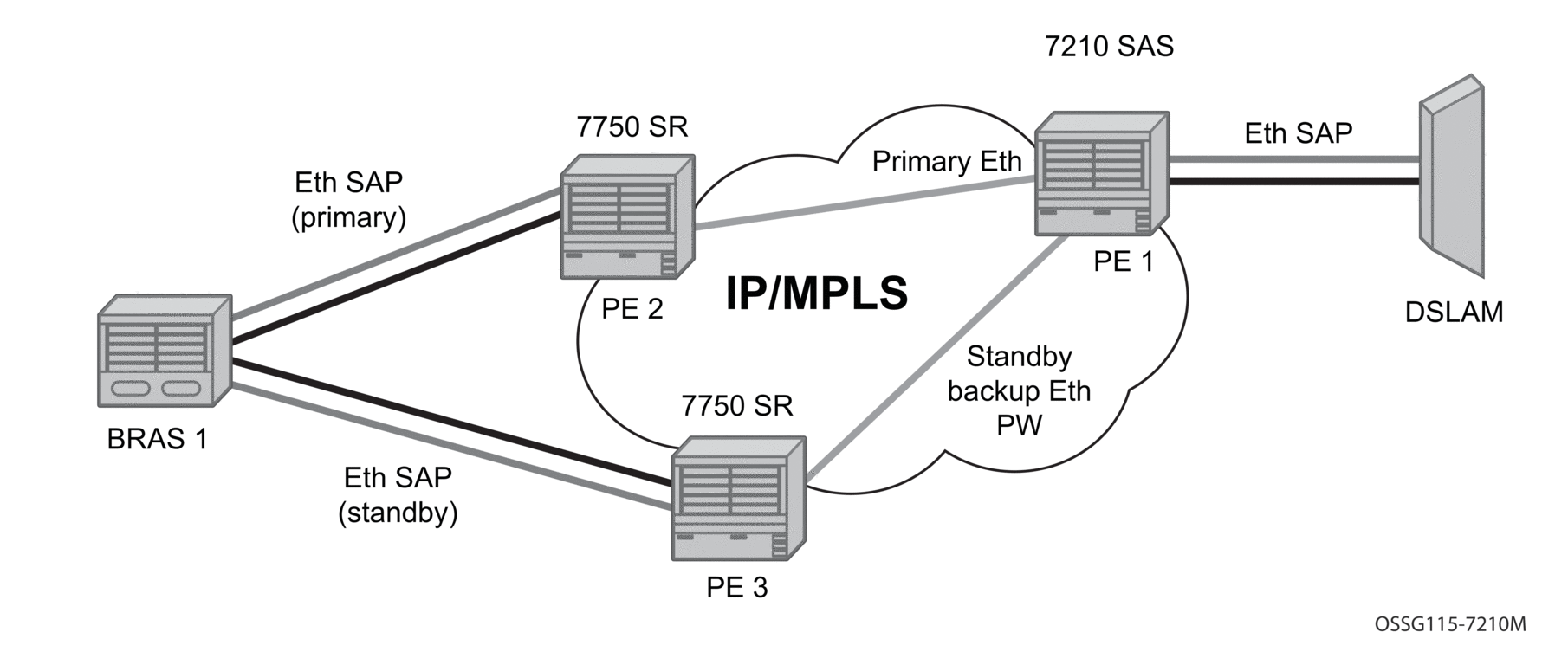
If the Ethernet SAP on PE2 fails, PE2 notifies PE1 of the failure by either withdrawing the primary pseudowire label it advertised or by sending a pseudowire status notification with the code set to indicate a SAP defect. PE1 will receive it and will immediately switch its local SAP to forward over the secondary standby spoke-SDP. To avoid black holing of in-flight packets during the switching of the path, PE1 will accept packets received from PE2 on the primary pseudowire while transmitting over the backup pseudowire.
When the SAP at PE2 is restored, PE2 updates the new status of the SAP by sending a new label mapping message for the same pseudowire FEC or by sending pseudowire status notification message indicating that the SAP is back up. PE1 then starts a timer and reverts back to the primary at the expiry of the timer. By default, the timer is set to 0, which means PE1 reverts immediately. A special value of the timer (infinity) will mean that PE1 should never revert back to the primary pseudowire.
The behavior of the pseudowire redundancy feature is the same if PE1 detects or is notified of a network failure that brought the spoke-SDP operational status to DOWN. The following are the events which will cause PE1 to trigger a switchover to the secondary standby pseudowire:
- T-LDP peer (remote PE) node withdrew the pseudowire label.
- T-LDP peer signaled a FEC status indicating a pseudowire failure or a remote SAP failure.
- T-LDP session to peer node times out.
- SDP binding and VLL service went down as a result of network failure condition such as the SDP to peer node going operationally down.
The 7210 SAS routers support the ability to configure multiple secondary standby pseudowire paths. For example, PE1 uses the value of the user configurable precedence parameter associated with each spoke-SDP to select the next available pseudowire path after the failure of the current active pseudowire (whether it is the primary or one of the secondary pseudowires). The revertive operation always switches the path of the VLL back to the primary pseudowire though. There is no revertive operation between secondary paths meaning that the path of the VLL will not be switched back to a secondary pseudowire of higher precedence when the latter comes back up again.
-The 7210 SAS routers support the ability for a user-initiated manual switchover of the VLL path to the primary or any of the secondary be supported to divert user traffic in case of a planned outage such as in node upgrade procedures.
3.3.4. Dynamic Multi-Segment Pseudowire Routing
| Note: T-PE functionality is supported on all 7210 SAS platforms as described in this document, except those operating in access-uplink mode. S-PE functionality is only supported on 7210 SAS-Mxp, 7210 SAS-Sx/S 1/10GE, and 7210 SAS-Sx 10/100GE. The following sections describe the end-to-end solution with BGP PW-routing, assuming appropriate platforms are used for various functions. |
Dynamic Multi-Segment Pseudowire Routing (Dynamic MS-PWs) enable a complete multi-segment pseudowire to be established, while only requiring per-pseudowire configuration on the T-PEs. No per-pseudowire configuration is required on the S-PEs. End-to-end signaling of the MS-PW is achieved using T-LDP, while multi-protocol BGP is used to advertise the T-PEs, so allowing dynamic routing of the MS-PW through the intervening network of S-PEs. Dynamic multi-segment pseudowires are described in the IETF in draft-ietf-pwe3-dynamic-ms-pw-13.txt.
Figure 24 shows the operation of dynamic MS-PWs.
Figure 24: Dynamic MS-PW Overview
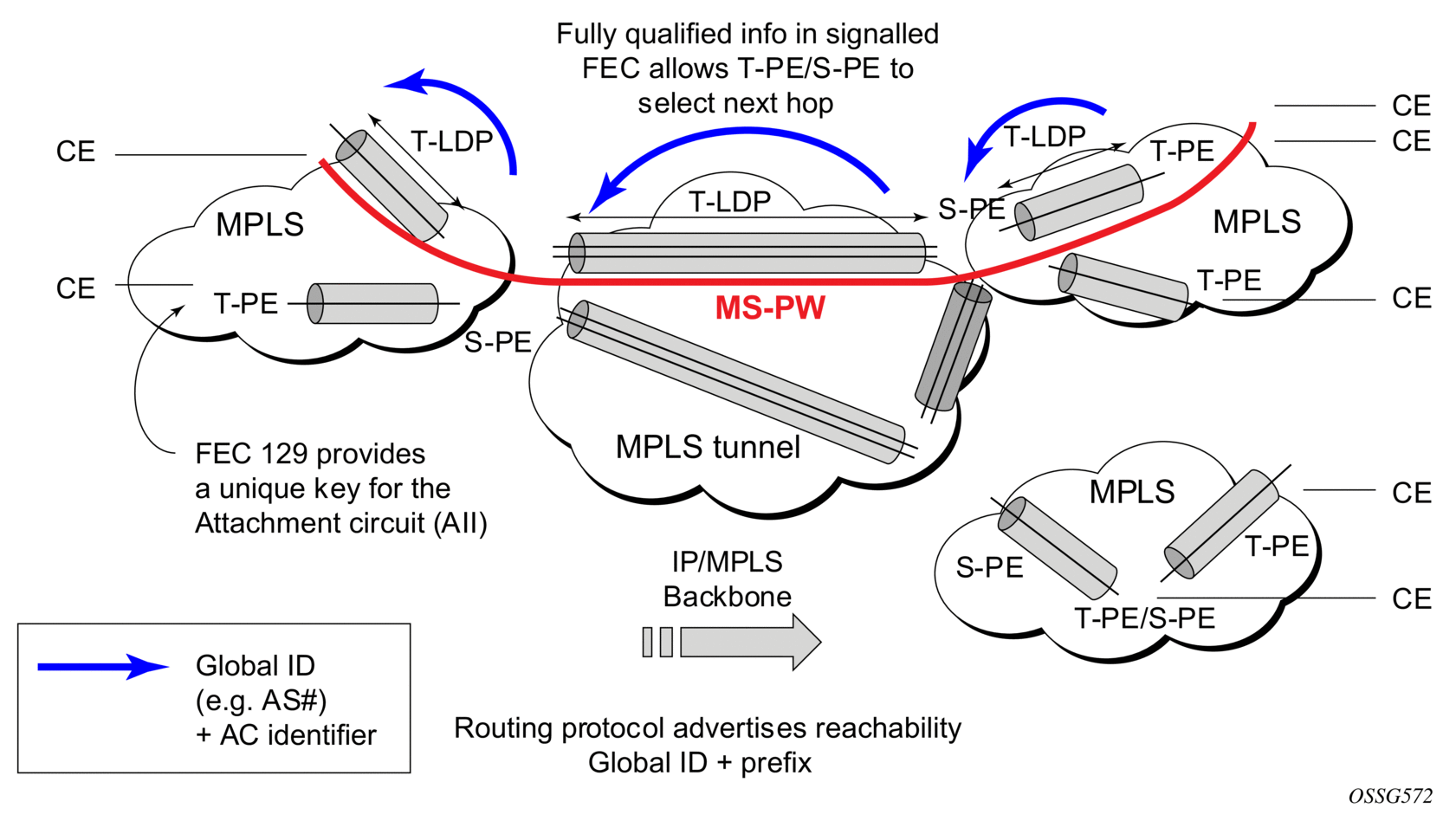
The FEC 129 AII Type 2 structure shown in Figure 25 is used to identify each individual pseudowire endpoint:
Figure 25: Figure 2 MS-PW Addressing using FEC129 AII Type 2
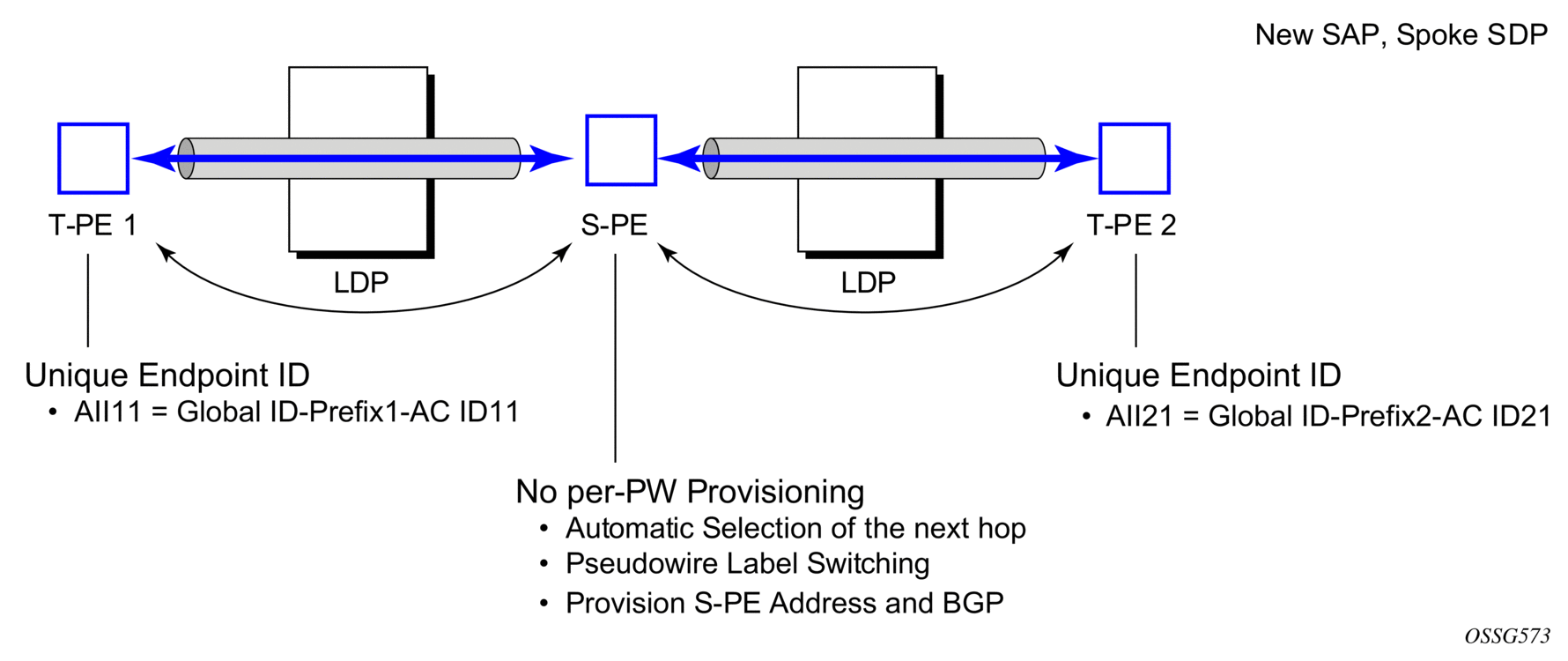
A 4-byte global ID followed by a 4 byte prefix and a 4 byte attachment circuit ID are used to provide for hierarchical, independent allocation of addresses on a per service provider network basis. The first 8 bytes (Global ID + Prefix) may be used to identify each individual T-PE or S-PE as a loopback Layer 2 Address.
This new AII type is mapped into the MS-PW BGP NLRI (a new BGP AFI of L2VPN, and SAFI for network layer reachability information for dynamic MS-PWs. As soon as a new T- PE is configured with a local prefix address of global id:prefix, pseudowire routing will proceed to advertise this new address to all the other T- PEs and S-PEs in the network, as shown in Figure 26.
Figure 26: Advertisement of PE Addresses by PW Routing
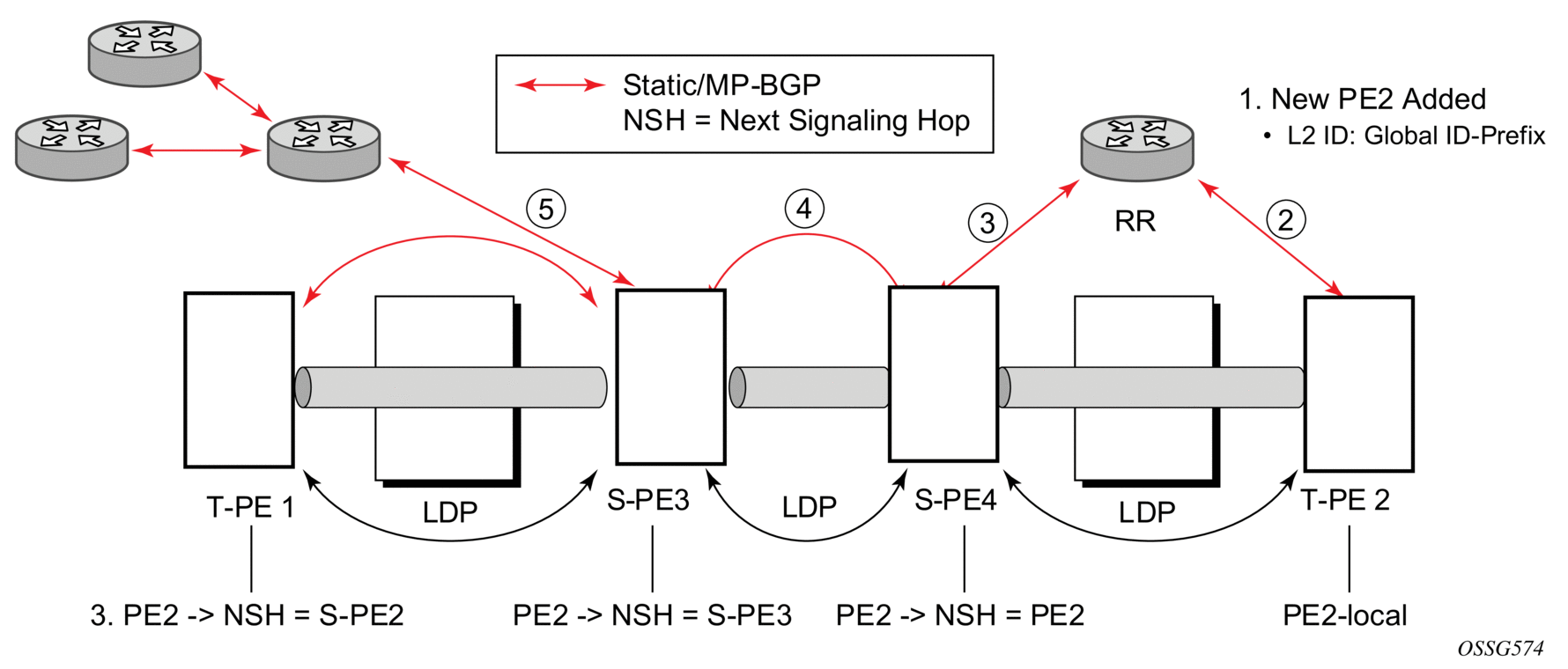
In step 1 a new T-PE (T-PE2) is configured with a local prefix.
Next, in steps 2-5, MP-BGP will use the NLRI for the MS-PW routing SAFI to advertise the location of the new T-PE to all the other PEs in the network. Alternatively, static routes may be configured on a per T-PE/S-PE basis to accommodate non-BGP PEs in the solution.
As a result, pseudowire routing tables for all the S-PEs and remote T-PEs are populated with the next hop to be used to reach T-PE2.
VLL services can then be established, as shown in Figure 27.
Figure 27: Signaling of Dynamic MS-PWs using T-LDP
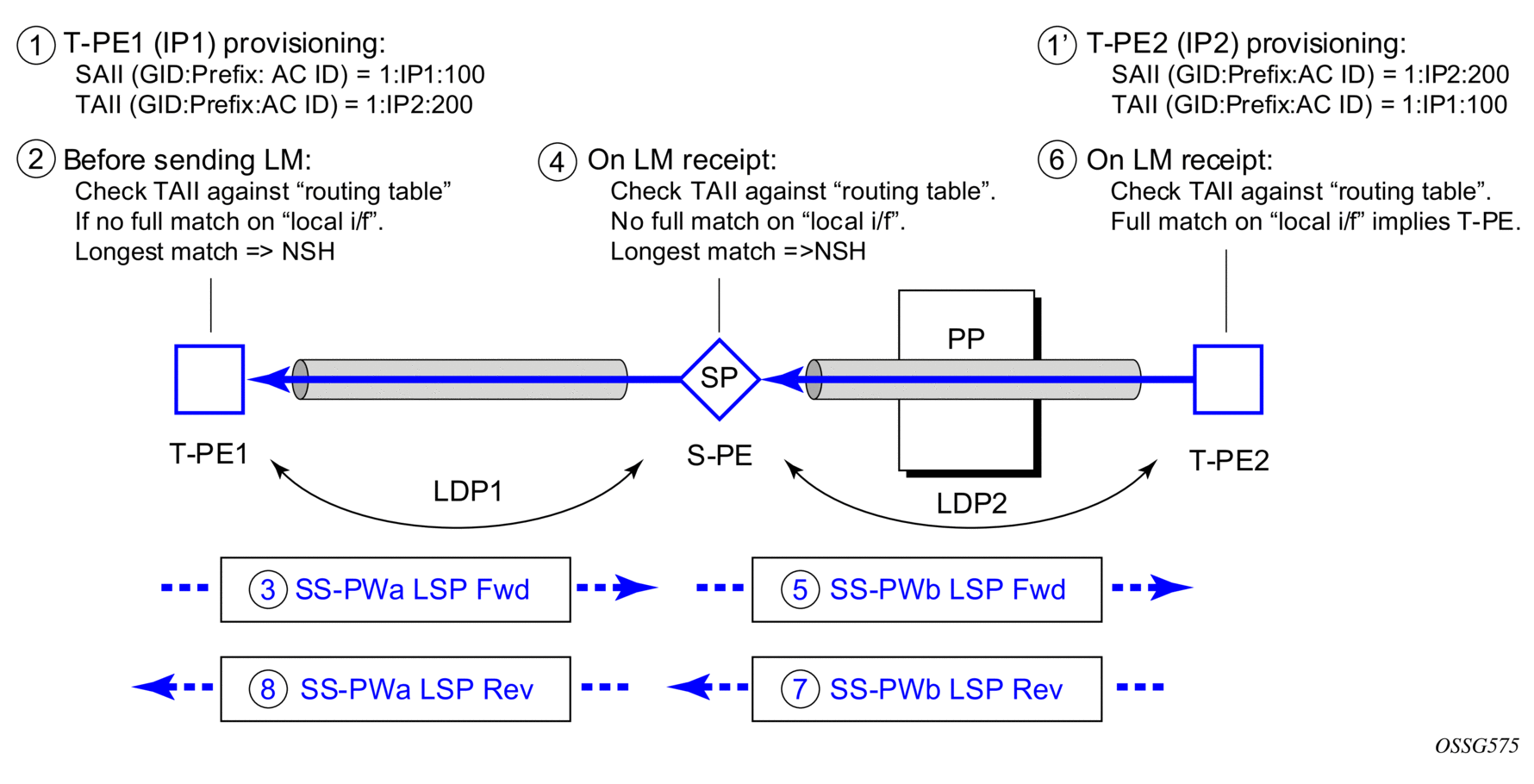
In step 1 and 1' the T-PEs are configured with the local and remote endpoint information, Source AII (SAII), Target AII (TAII). On the 7210, the AIIs are locally configured for each spoke-SDP, according to the model shown in Figure 28. The 7210 therefore provides for a flexible mapping of AII to SAP. That is, the values used for the AII are through local configuration, and it is the context of the spoke-SDP that binds it to a specific SAP.
Figure 28: Mapping of AII to SAP
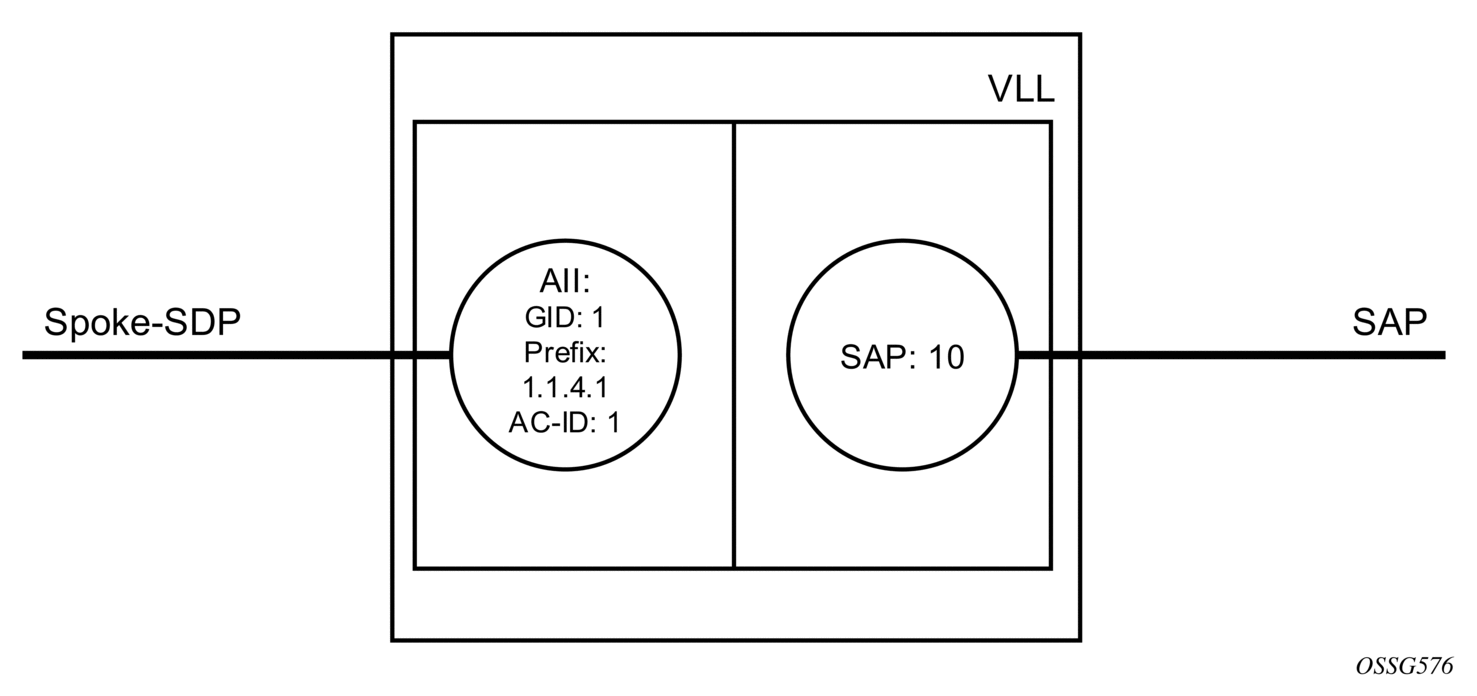
Before T-LDP signaling starts, the two T-PEs decide on an active and passive relationship using the highest AII (comparing the configured SAII and TAII) or the configured precedence. Next, the active T-PE (in the IETF draft this is referred to as the source T-PE or ST-PE) checks the PW Routing Table to determine the next signaling hop for the configured TAII using the longest match between the TAII and the entries in the PW routing table
This signaling hop is then used to choose the T-LDP session to the chosen next-hop S-PE. Signaling proceeds through each subsequent S-PE using similar matching procedures to determine the next signaling hop. Otherwise, if a subsequent S-PE does not support dynamic MS-PW routing and therefore uses a statically configured PW segment, the signaling of individual segments follows the procedures already implemented in the PW Switching feature. Note that BGP can install a PW AII route in the PW routing table with ECMP next-hops. However when LDP needs to signal a PW with matching TAII, it will choose only one next-hop from the available ECMP next-hops. PW routing supports up to 4 ECMP paths for each destination.
The signaling of the forward path ends when the PE matches the TAII in the label mapping message with the SAII of a spoke-SDP bound to a local SAP. The signaling in the reverse direction can now be initiated, which follows the entries installed in the forward path. The PW Routing tables are not consulted for the reverse path. This ensures that the reverse direction of the PW follows exactly the same set of S-PEs as the forward direction.
This solution can be used in either a MAN-WAN environment or in an Inter-AS/Inter-Provider environment as shown in Figure 29.
Figure 29: VLL Using Dynamic MS-PWs, Inter-AS Scenario
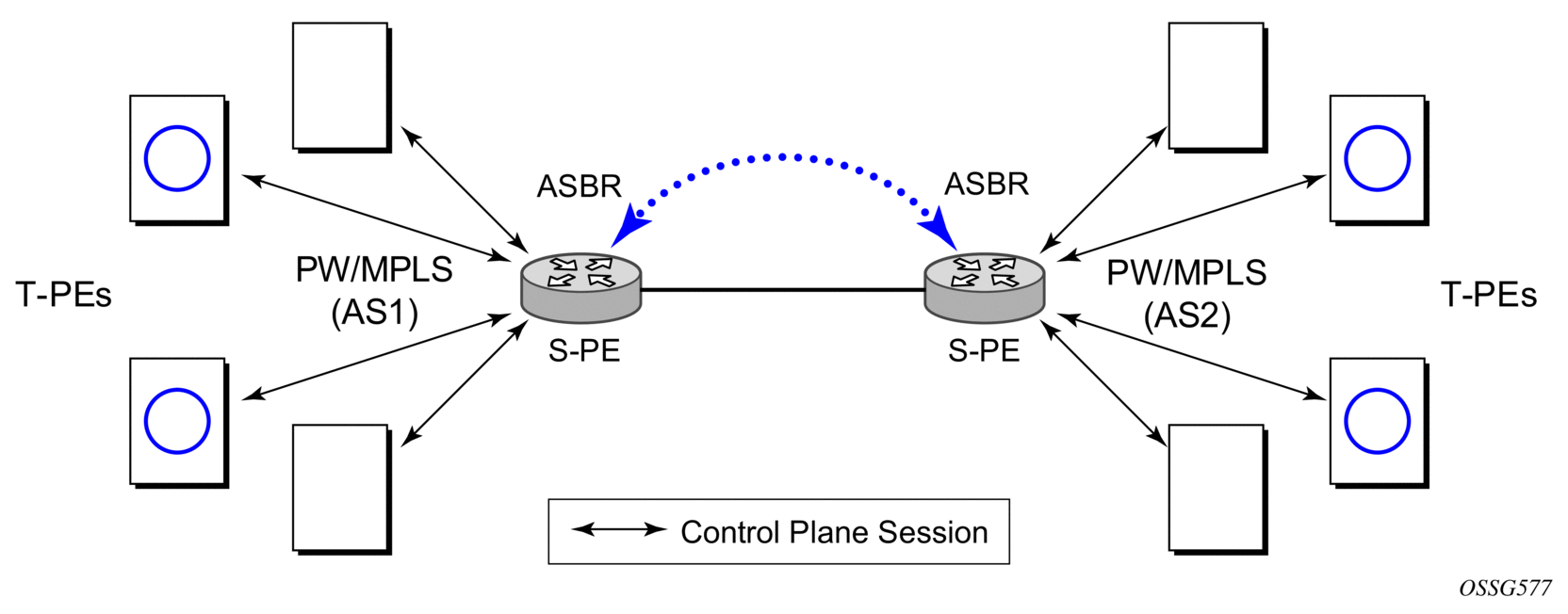
Note that data plane forwarding at the S-PEs uses pseudowire service label switching, as per the pseudowire switching feature.
3.3.4.1. Pseudowire Routing
Each S-PE and T-PE has a pseudowire routing table that contains a reference to the T-LDP session to use to signal to a set of next hop S-PEs to reach a specific T-PE (or the T-PE if that is the next hop). For VLLs, this table contains aggregated AII Type 2 FECs and may be populated with routes that are learned through MP-BGP or that are statically configured.
MP-BGP is used to automatically distribute T-PE prefixes using the new MS-PW NLRI, or static routes can be used. The MS-PW NLRI is composed of a Length, an 8-byte RD, a 4-byte Global-ID, a 4-byte local prefix, and (optionally) a 4-byte AC-ID. Support for the MS-PW address family is configured in CLI under config>router>bgp>family ms-pw.
MS-PW routing parameters are configured in the config>service>pw-routing context.
To enable support for dynamic MS-PWs on a 7210 node to be used as a T-PE or S-PE, a single, globally unique, S-PE ID, known as the S-PE Address, is first configured under config>service>pw-routing on each 7210 to be used as a T-PE or S-PE. The S-PE Address has the format global-id:prefix. It is not possible to configure any local prefixes used for pseudowire routing or to configure spoke SPDs using dynamic MS-PWs at a T-PE unless an S-PE address has already been configured. The S-PE address is used as the address of a node used to populate the switching point TLV in the LDP label mapping message and the pseudowire status notification sent for faults at an S-PE.
Each T-PE is also be configured with the following parameters:
- Global ID — This is a 4 byte identifier that uniquely identifies an operator or the local network.
- Local Prefix — One or more local (Layer 2) prefixes (up to a maximum of 16), which are formatted in the style of a 4-octet IPv4 address. A local prefix identifies a T-PE or S-PE in the PW routing domain.
- For each local prefix, at least one 8-byte route distinguisher can be configured. It is also possible to configure an optional BGP community attribute.
For each local prefix, BGP then advertises each global ID/prefix tuple and unique RD and community pseudowire using the MS-PW NLRI, based on the aggregated FEC129 AII Type 2 and the Layer 2 VPN/PW routing AFI/SAFI 25/6, to each T-PE/S-PE that is a T-LDP neighbor, subject to local BGP policies.
The dynamic advertisement of each of these pseudowire routes is enabled for each prefix and RD using the advertise-bgp command.
An export policy is also required to export MS-PW routes in MP-BGP. This can be done using a default policy, such as the following.
However, this would export all routes. A recommended choice is to enable filtering per-family, as follows.
The following command is then added in the config>router>bgp context.
Local-preference for iBGP and BGP communities can be configured under such a policy.
3.3.4.1.1. Static Routing
In addition to support for BGP routing, static MS-PW routes may also be configured using the config>services>pw-routing>static-route command. Each static route comprises the target T-PE Global-ID and prefix, and the IP address of the T-LDP session to the next hop S-PE or T-PE that should be used.
If a static route is set to 0, then this represents the default route. If a static route exists to a specific T-PE, then this is used in preference to any BGP route that may exist.
3.3.4.1.2. Explicit Paths
A set of default explicit routes to a remote T-PE or S-PE prefix may be configured on a T-PE under config>services>pw-routing using the path name command. Explicit paths are used to populate the explicit route TLV used by MS-PW T-LDP signaling. Only strict (fully qualified) explicit paths are supported.
Note that it is possible to configure explicit paths independently of the configuration of BGP or static routing.
3.3.4.2. Configuring VLLs using Dynamic MS-PWs
One or more spoke-SDPs may be configured for distributed Epipe VLL services. Dynamic MS-PWs use FEC129 (also known as the Generalized ID FEC) with Attachment Individual Identifier (AII) Type 2 to identify the pseudowire, as opposed to FEC128 (also known as the PW ID FEC) used for traditional single segment pseudowires and for pseudowire switching. FEC129 spoke-SDPs are configured under the spoke-sdp-fec command in the CLI.
FEC129 AII Type 2 uses a Source Attachment Individual Identifier (SAII) and a Target Attachment Individual Identifier (TAII) to identify the end of a pseudowire at the T-PE. The SAII identifies the local end, while the TAII identifies the remote end. The SAII and TAII are each structured as follows:
- Global-ID — This is a 4 byte identifier that uniquely identifies an operator or the local network.
- Prefix — A 4-byte prefix, which should correspond to one of the local prefixes assigned under pw-routing.
- AC-ID — A 4-byte identifier for this end of the pseudowire. This should be locally unique within the scope of the global-id:prefix.
3.3.4.2.1. Active/Passive T-PE Selection
Dynamic MS-PWs use single-sided signaling procedures with double-sided configuration, a fully qualified FEC must be configured at both endpoints. That is, one T-PE (the source T-PE, ST-PE) of the MS-PW initiates signaling for the MS-PW, while the other end (the terminating T-PE, TT-PE) passively waits for the label mapping message from the far-end and only responds with a label mapping message to set up the opposite direction of the MS-PW when it receives the label mapping from the ST-PE. By default, the 7210 will determine which T-PE is the ST-PE (the active T-PE) and which is the TT-PE (the passive T-PE) automatically, based on comparing the SAII with the TAII as unsigned integers. The T-PE with SAII>TAII assumes the active role. However, it is possible to override this behavior using the signaling {master | auto} command under the spoke-sdp-fec. If master is selected at a specific T-PE, then it will assume the active role. If a T-PE is at the endpoint of a spoke-SDP that is bound to an VLL SAP and single sided auto-configuration is used, then that endpoint is always passive. Therefore, signaling master should only be used when it is known that the far end will assume a passive behavior.
3.3.4.2.2. Automatic Endpoint Configuration
Automatic endpoint configuration allows the configuration of an endpoint without specifying the TAII associated with that spoke-sdp-fec. It allows a single-sided provisioning model where an incoming label mapping message with a TAII that matches the SAII of that spoke-SDP to be automatically bound to that endpoint. This is useful in scenarios where a service provider wishes to separate service configuration from the service activation phase.
Automatic endpoint configuration is supported required for Epipe VLL spoke-sdp-fec endpoints bound to a VLL SAP. It is configured using the spoke-sdp-fec>auto-config command, and excluding the TAII from the configuration. When auto-configuration is used, the node assumed passive behavior from a point of view of T-LDP signaling. Therefore, the far-end T-PE must be configured for signaling master for that spoke-sdp-fec.
3.3.4.2.3. Selecting a Path for an MS-PW
Path selection for signaling occurs in the outbound direction (ST-PE to TT-PE) for an MS-PW. In the TT-PE to ST-PE direction, a label mapping message follows the reverse of the path already taken by the outgoing label mapping.
A node can use explicit paths, static routes, or BGP routes to select the next hop S-PE or T-PE. The order of preference used in selecting these routes is:
- Explicit Path
- Static route
- BGP route
To use an explicit path for an MS-PW, an explicit path must have been configured in the config>services>pw-routing>path path-name context. The user must then configure the corresponding path path-name under spoke-sdp-fec.
If an explicit path name is not configured, then the TT-PE or S-PE will perform a longest match lookup for a route (static if it exists, and BGP if not) to the next hop S-PE or T-PE to reach the TAII.
Pseudowire routing chooses the MS-PW path in terms of the sequence of S-PEs to use to reach a specific T-PE. It does not select the SDP to use on each hop, which is instead determined at signaling time. When a label mapping is sent for a specific pseudowire segment, an LDP SDP will be used to reach the next-hop S-PE/T-PE if such an SDP exists. If not, and a RFC 3107 labeled BGP SDP is available, then that will be used. Otherwise, the label mapping will fail and a label release will be sent.
3.3.4.2.4. Pseudowire Templates
Dynamic MS-PWs support the use of the pseudowire template for specifying generic pseudowire parameters at the T-PE. The pseudowire template to use is configured in the spoke-sdp-fec>pw-template-bind policy-id context. Dynamic MS-PWs do not support the provisioned SDPs specified in the pseudowire template.
3.3.4.3. Pseudowire Redundancy
Pseudowire redundancy is supported on dynamic MS-PWs used for VLLs. It is configured in a similar manner to pseudowire redundancy on VLLs using FEC128, whereby each spoke-sdp-fec within an endpoint is configured with a unique SAII/TAII.
Figure 30 shows the use of pseudowire redundancy.
Figure 30: Pseudowire Redundancy
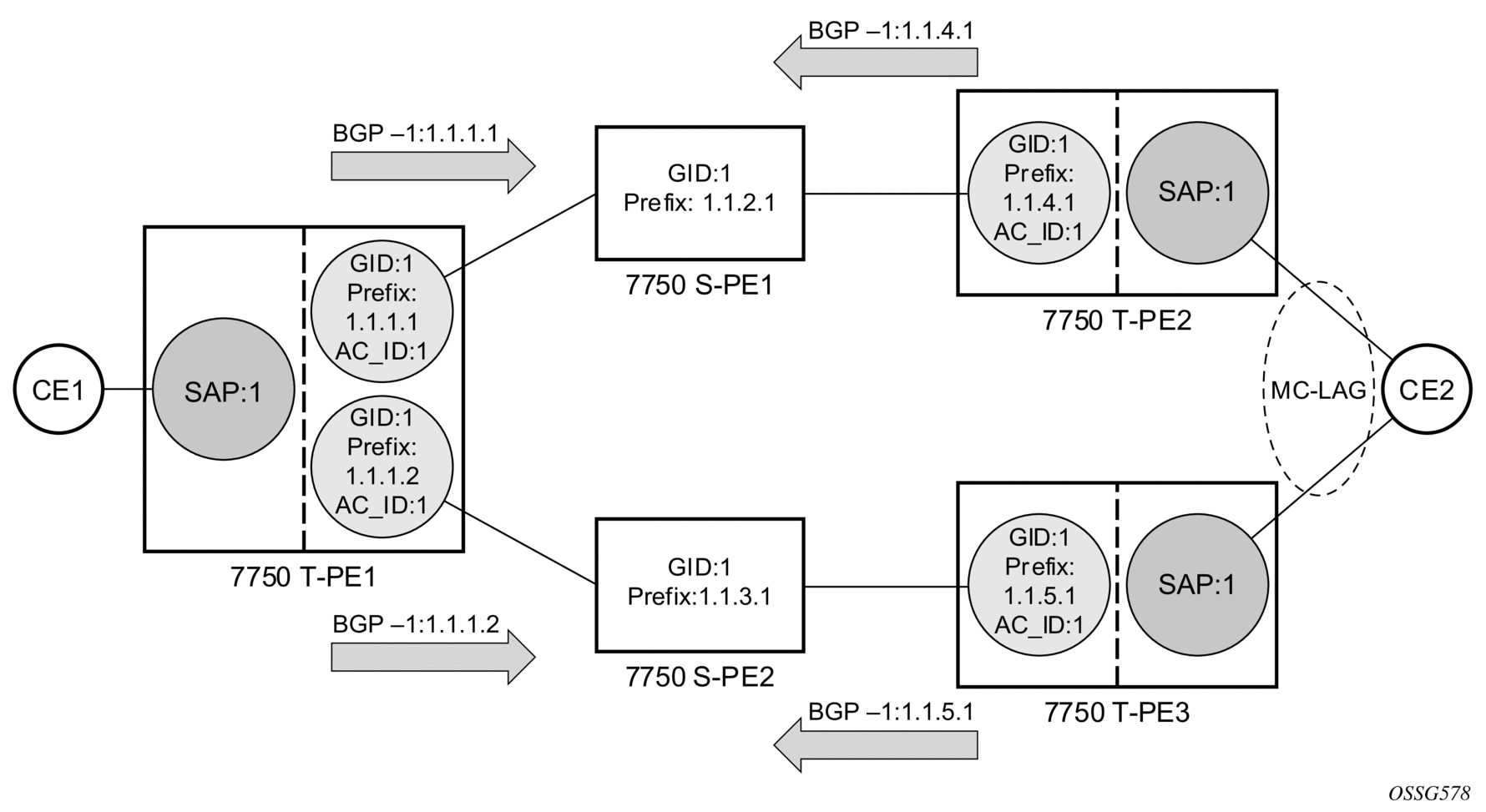
The following is a summary of the key points to consider in using pseudowire redundancy with dynamic MS-PWs:
- Each MS-PW in the redundant set must have a unique SAII/TAII set and is signaled separately. The primary pseudowire is configured in the spoke-sdp-fec>primary context.
- Each MS-PW in the redundant set should use a diverse path (from the point of view of the S-PEs traversed) from every other MS-PW in that set if path diversity is possible in a specific network topology. There are a number of possible ways to achieve this:
- Configure an explicit path for each MS-PW.
- Allow BGP routing to automatically determine diverse paths using BGP policies applied to different local prefixes assigned to the primary and standby MS-PWs.
- Path diversity can be further provided for each primary pseudowire through the use of a BGP route distinguisher.
If the primary MS-PW fails, fail-over to a standby MS-PW, as per the normal pseudowire redundancy procedures. A configurable retry timer for the failed primary MS-PW is then started. When the timer expires, attempt to reestablish the primary MS-PW using its original path, up to a maximum number of attempts as per the retry count parameter. The T-PE may then optionally revert back to the primary MS-PW on successful reestablishment.
Note that since the SDP ID is determined dynamically at signaling time, it cannot be used as a tie breaker to choose the primary MS-PW between multiple MS-PWs of the same precedence. The user should therefore explicitly configure the precedence values to determine which MS-PW is active in the final selection.
3.3.4.4. VCCV OAM for Dynamic MS-PWs
The primary difference between dynamic MS-PWs and those using FEC128 is support for FEC129 AII type 2. As in PW Switching, VCCV on dynamic MS-PWs requires the use of the VCCV control word on the pseudowire. Both the vccv-ping and vccv-trace commands support dynamic MS-PWs.
3.3.4.5. VCCV-Ping on Dynamic MS-PWs
VCCV-ping supports the use of FEC129 AII type 2 in the target FEC stack of the ping echo request message. The FEC to use in the echo request message is derived in one of two ways: Either the user can specify only the spoke-sdp-fec-id of the MS-PW in the vccv-ping command, or the user can explicitly specify the SAII and TAII to use.
If the SAII:TAII is entered by the user in the vccv-ping command, then those values are be used for the vccv-ping echo request, but their order is be reversed before being sent so that they match the order for the downstream FEC element for an S-PE, or the locally configured SAII:TAII for a remote T-PE of that MS-PW. Note that is SAII:TAII is entered in addition to the spoke-sdp-fec-id, then the system will verify the entered values against the values stored in the context for that spoke-sdp-fec-id.
Otherwise, if the SAII:TAII to use in the target FEC stack of the vccv-ping message is not entered by the user, and if a switching point TLV was previously received in the initial label mapping message for the reverse direction of the MS-PW (with respect to the sending PE), then the SAII:TAII to use in the target FEC stack of the vccv-ping echo request message is derived by parsing that switching point TLV based on the user-specified TTL (or a TTL of 255 if none is specified). In this case, the order of the SAII:TAII in the switching point TLV is maintained for the vccv-ping echo request message.
If no pseudowire switching point TLV was received, then the SAII:TAII values to use for the vccv-ping echo request are derived from the MS-PW context, but their order is reversed before being sent so that they match the order for the downstream FEC element for an S-PE, or the locally configured SAII:TAII for a remote T-PE of that MS-PW.
Note that the use of spoke-sdp-fec-id in vccv-ping is only applicable at T-PE nodes, since it is not configured for a specific MS-PW at S-PE nodes.
3.3.4.6. VCCV-Trace on Dynamic MS-PWs
The 7210 supports the MS-PW path trace mode of operation for VCCV trace, as per pseudowire switching, but using FEC129 AII type 2. As in the case of vccv-ping, the SAII:TAII used in the VCCV echo request message sent from the T-PE or S-PE from which the VCCV trace command is executed is specified by the user or derived from the context of the MS-PW. Note that the use of spoke-sdp-fec-id in vccv-trace is only applicable at T-PE nodes, since it is not configured for a specific MS-PW at S-PE nodes.
3.3.5. Example Dynamic MS-PW Configuration
Figure 31 shows how to configure Dynamic MS-PWs for a VLL service between a set of 7210 nodes. The network consists of two 7210 T-PEs and two 7210s in the role of S-PEs. Each 7210 peers with its neighbor using LDP and BGP.
Figure 31: Dynamic MS-PW Example

The example uses BGP to route dynamic MS-PWs and T-LDP to signal them. Therefore each node must be configured to support the MS-PW address family under BGP, and BGP and LDP peerings must be established between the T-PEs/S-PEs. The appropriate BGP export policies must also be configured.
Next, pseudowire routing must be configured on each node. This includes an S-PE address for every participating node, and one or more local prefixes on the T-PEs. MS-PW paths and static routes may also be configured. When this routing and signaling infrastructure is established, spoke-sdp-fecs can be configured on each of the T-PEs.
T-PE-1
T-PE-2
S-PE-1
S-PE-2
3.4. Master-Slave Operation
| Note: The standby-signaling-master command is supported on all 7210 SAS platforms as described in this document, except for those operating in access-uplink mode. The standby-signaling-slave command is not supported. In the following section, references to the standby-signaling-slave command are only used to describe the complete solution. 7210 SAS platforms can only be used where the standby-signaling-master command is used in the example. |
Master-Slave pseudowire redundancy is discussed in this section. It adds the ability for the remote peer to react to the pseudowire standby status notification, even if only one spoke-SDP terminates on the VLL endpoint on the remote peer, by blocking the transmit (Tx) direction of a VLL spoke-SDP when the far-end PE signals standby. This solution enables the blocking of the Tx direction of a VLL spoke-SDP at both master and slave endpoints when standby is signalled by the master endpoint. This approach satisfies a majority of deployments where bidirectional blocking of the forwarding on a standby spoke-SDP is required.
Figure 32 shows the operation of master-slave pseudowire redundancy. In this scenario, an Epipe service is provided between CE1 and CE2. CE2 is dual homed to PE2 and PE3, and therefore PE1 is dual-homed to PE2 and PE3 using Epipe spoke-SDPs. The objectives of this feature is to ensure that only one pseudowire is used for forwarding in both directions by PE1, PE2 and PE3 in the absence of a native dual homing protocol between CE2 and PE2/PE3, such as MC-LAG. In normal operating conditions (the SAPs on PE2 and PE3 toward CE2 are both up and there are no defects on the ACs to CE2), PE2 and PE3 cannot choose which spoke-SDP to forward on based on the status of the AC redundancy protocol.
Figure 32: Master-Slave Pseudowire Redundancy
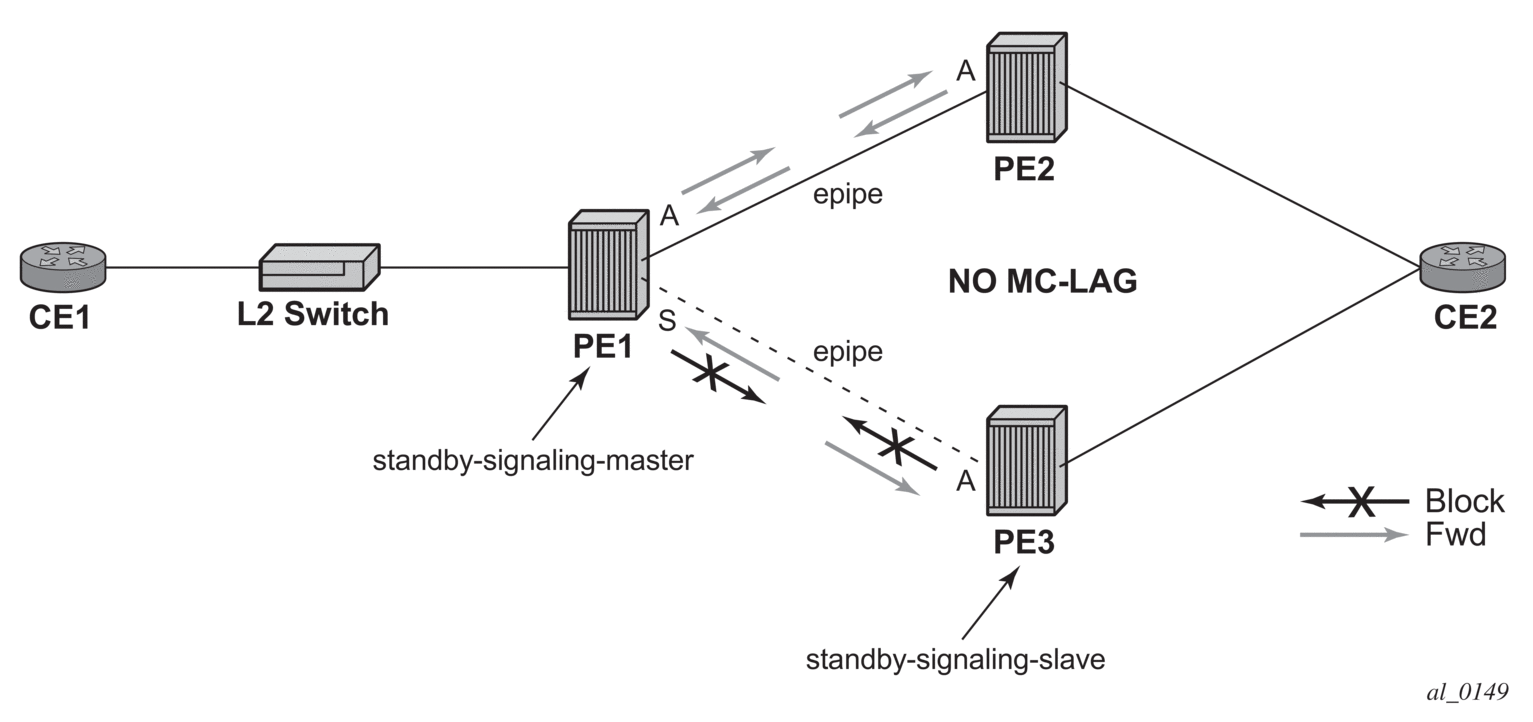
Master-slave pseudowire redundancy adds the ability for the remote peer to react to the pseudowire standby status notification, even if only one spoke-SDP terminates on the VLL endpoint on the remote peer. When the CLI command standby-signaling-slave is enabled at the spoke-SDP or explicit endpoint level in PE2 and PE3, then any spoke-SDP for which the remote peer signals PW FWD Standby will be blocked in the transmit direction.
This is achieved as follows. The standby-signaling-master state is activated on the VLL endpoint in PE1. In this case, a spoke-SDP is blocked in the transmit direction at this master endpoint if it is either in operDown state, or it has lower precedence than the highest precedence spoke-SDP, or the specific peer PE signals one of the following pseudowire status bits:
- Pseudowire not forwarding (0x01)
- SAP (ingress) receive fault (0x02)
- SAP (egress) transmit fault (0x04)
- SDP binding (ingress) receive fault (0x08)
- SDP binding (egress) transmit fault (0x10)
The fact that the specific spoke-SDP has been blocked will be signaled to LDP peer through the pseudowire status bit (PW FWD Standby (0x20)). This will prevent traffic being sent over this spoke-SDP by the remote peer, but obviously only in case that remote peer supports and reacts to pseudowire status notification. Previously, this applied only if the spoke-SDP terminates on an IES, VPRN or VPLS.
Note that although master-slave operation provides bidirectional blocking of a standby spoke-SDP during steady-state conditions, it is possible that the Tx directions of more than one slave endpoint can be active for transient periods during a fail-over operation. This is due to slave endpoints transitioning a spoke-SDP from standby to active receiving and/or processing a pseudowire preferential forwarding status message before those transitioning a spoke-SDP to standby. This transient condition is most likely when a forced switch-over is performed, or the relative preferences of the spoke-SDPs is changed, or the active spoke-SDP is shutdown at the master endpoint. During this period, loops of unknown traffic may be observed. Fail-overs due to common network faults that can occur during normal operation, a failure of connectivity on the path of the spoke-SDP or the SAP, would not result in such loops in the data path.
3.4.1. Operation of Master-Slave Pseudowire Redundancy with Existing Scenarios
This section illustrates how master-slave pseudowire redundancy could operate.
3.4.1.1. VLL Resilience
Figure 33 shows a VLL resilience path example. An sample configuration follows.
Figure 33: VLL Resilience
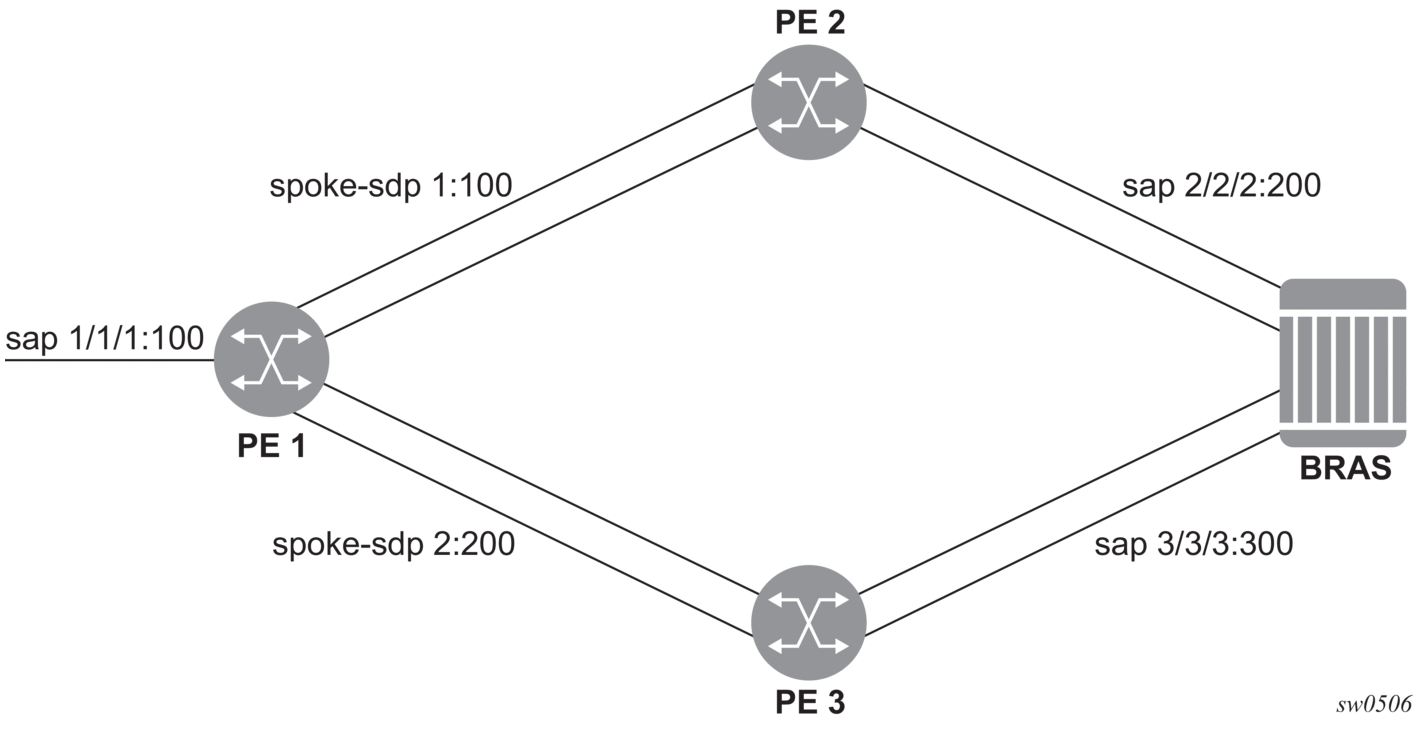
Note that a revert-time value of zero (default) means that the VLL path will be switched back to the primary immediately after it comes back up
PE3
3.4.2. VLL Resilience for a Switched PW Path
| Note: T-PE functionality is supported on all 7210 SAS platforms as described in this document, except those operating in access-uplink mode. S-PE functionality is only supported on 7210 SAS-Mxp, 7210 SAS-Sx/S 1/10GE, and 7210 SAS-Sx 10/100GE. |
Figure 34 shows a VLL resilience for a switched pseudowire path example. A sample configuration follows.
Figure 34: VLL Resilience with Pseudowire Switching

S-PE1
VC switching indicates a VC cross-connect so that the service manager does not signal the VC label mapping immediately but will put this into passive mode.
3.4.3. Access Node Resilience Using MC-LAG and Pseudowire Redundancy
Figure 35 shows the use of both Multi-Chassis Link Aggregation (MC-LAG) in the access network and pseudowire redundancy in the core network to provide a resilient end-to-end VLL service to the customers.
Figure 35: Access Node Resilience
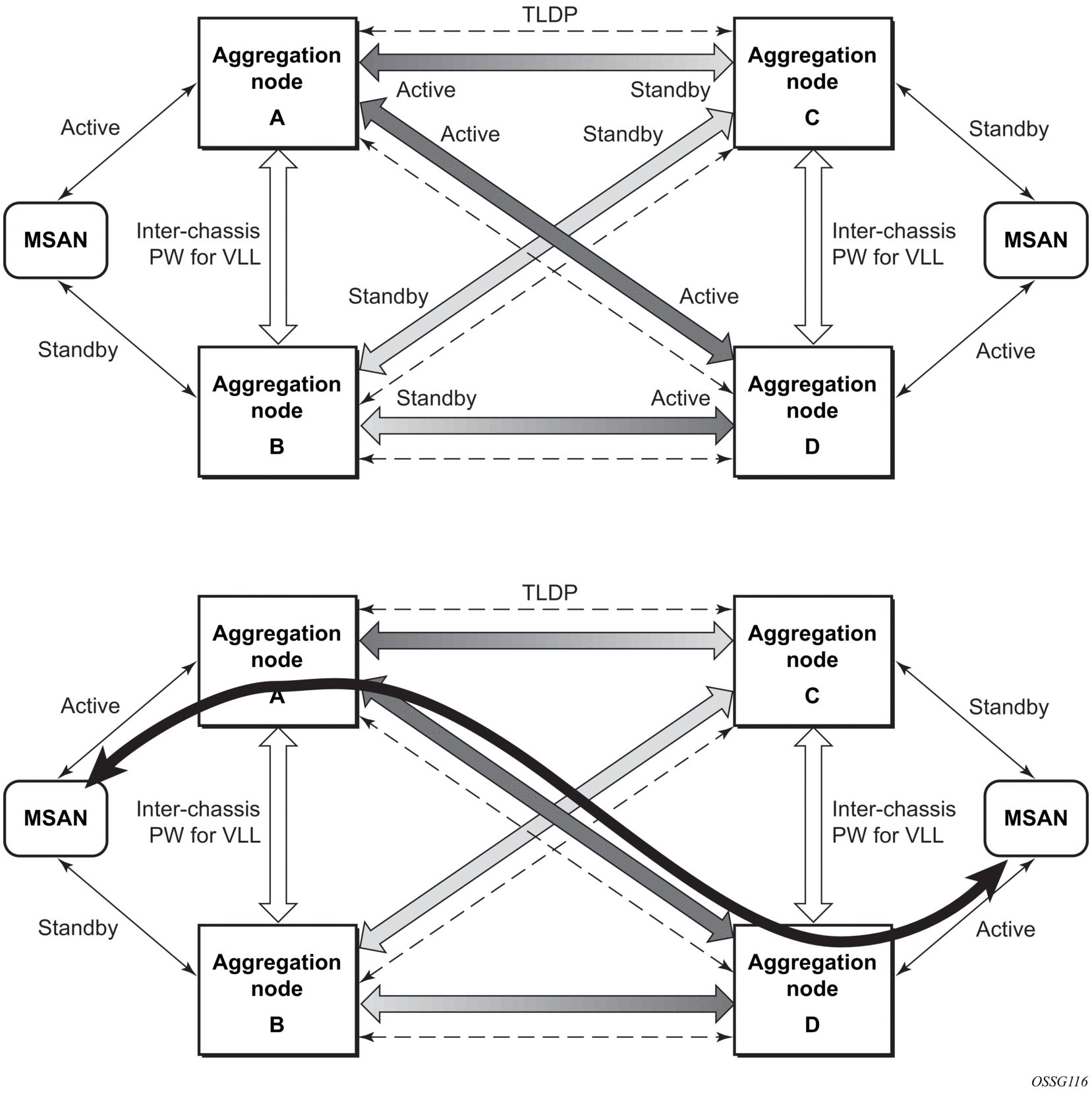
In this application, a new pseudowire status bit of active or standby indicates the status of the SAP in the MC-LAG instance in the 7210 SAS aggregation node. All spoke-SDPs are of secondary type and there is no use of a primary pseudowire type in this mode of operation. Node A is in the active state according to its local MC-LAG instance and therefore advertises active status notification messages to both its peer pseudowire nodes, for example, nodes C and D. Node D performs the same operation. Node B is in the standby state according to the status of the SAP in its local MC-LAG instance and therefore advertises standby status notification messages to both nodes C and D. Node C performs the same operation.
7210 SAS node selects a pseudowire as the active path for forwarding packets when both the local pseudowire status and the received remote pseudowire status indicate active status. However, a 7210 SAS device in standby status according to the SAP in its local MC-LAG instance is capable of processing packets for a VLL service received over any of the pseudowires which are up. This is to avoid black holing of user traffic during transitions. The 7210 SAS standby node forwards these packets to the active node bye the Inter-Chassis Backup pseudowire (ICB pseudowire) for this VLL service. An ICB is a spoke-SDP used by a MC-LAG node to backup a MC-LAG SAP during transitions. The same ICB can also be used by the peer MC-LAG node to protect against network failures causing the active pseudowire to go down.
Note that at configuration time, the user specifies a precedence parameter for each of the pseudowires which are part of the redundancy set as described in the application. A 7210 SAS node uses this to select which pseudowire to forward packet to in case both pseudowires show active/active for the local/remote status during transitions.
Only VLL service of type Epipe is supported in this application. Also, ICB spoke-SDP can only be added to the SAP side of the VLL cross-connect if the SAP is configured on a MC-LAG instance.
3.4.4. VLL Resilience for a Switched Pseudowire Path
Figure 36 shows the use of both pseudowire redundancy and pseudowire switching to provide a resilient VLL service across multiple IGP areas in a provider network.
Figure 36: VLL Resilience with Pseudowire Redundancy and Switching
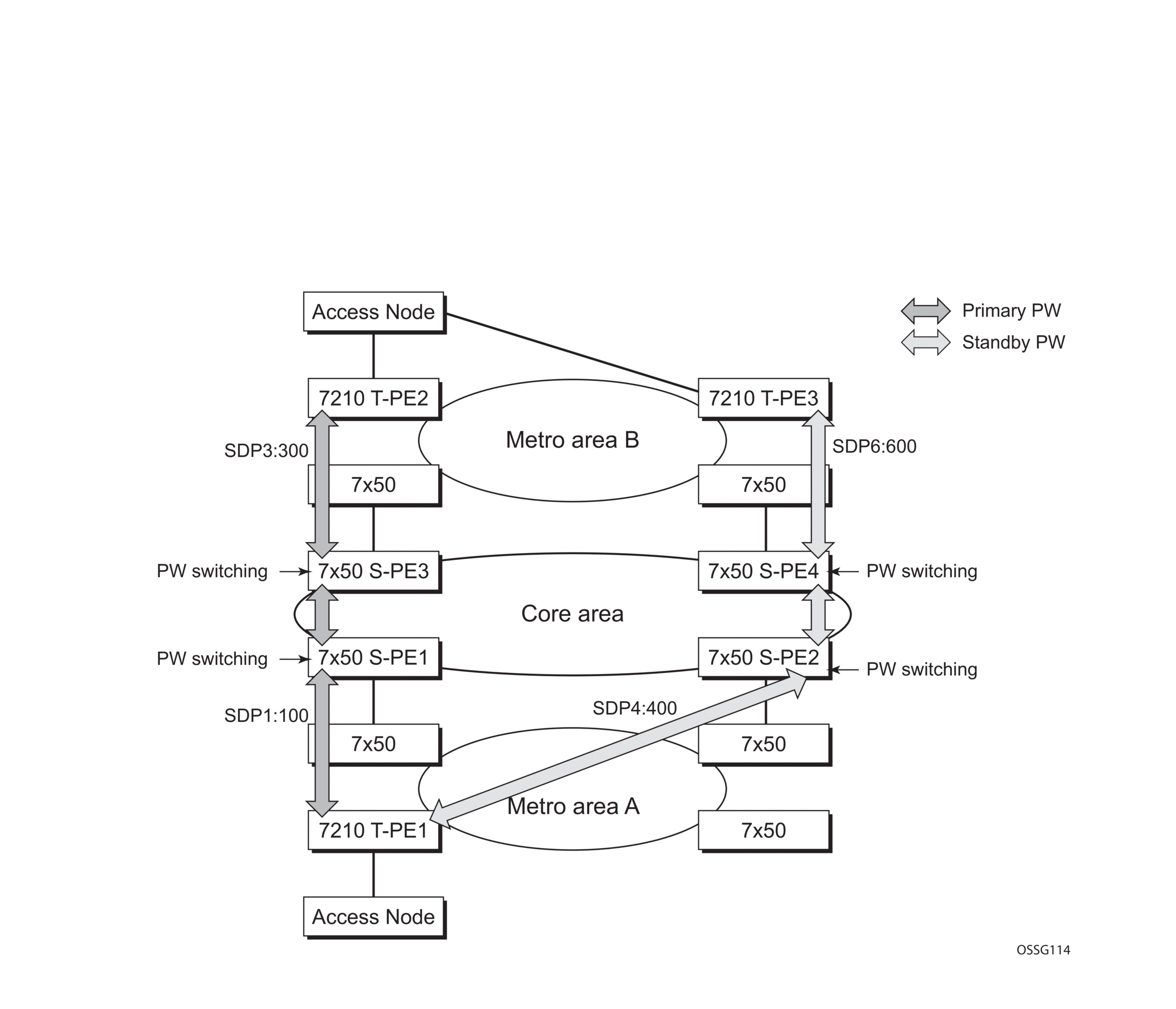
Pseudowire switching is a method for scaling a large network of VLL or VPLS services by removing the need for a full mesh of T-LDP sessions between the PE nodes as the number of these nodes grows over time.
Like in the application in VLL Resilience for a Switched Pseudowire Path, the T-PE1 node switches the path of a VLL to a secondary standby pseudowire in the case of a network side failure causing the VLL binding status to be DOWN or if T-PE2 notified it that the remote SAP went down. This application requires that pseudowire status notification messages generated by either a T-PE node or a S-PE node be processed and relayed by the S-PE nodes.
Note that it is possible that the secondary pseudowire path terminates on the same target PE as the primary, for example, T-PE2. This provides protection against network side failures but not against a remote SAP failure. When the target destination PE for the primary and secondary pseudowires is the same, T-PE1 will usually not switch the VLL path onto the secondary pseudowire upon receipt of a pseudowire status notification indicating the remote SAP is down since the status notification is sent over both the primary and secondary pseudowires. However, the status notification on the primary pseudowire may arrive earlier than the one on the secondary pseudowire due to the differential delay between the paths. This will cause T-PE1 to switch the path of the VLL to the secondary standby pseudowire and remain there until the status notification is cleared. At that point in time, the VLL path is switched back to the primary pseudowire due to the revertive behavior operation. The path will not switch back to a secondary path when it becomes up even if it has a higher precedence than the currently active secondary path.
3.5. Pseudowire Redundancy Service Models
This section describes the various MC-LAG and pseudowire redundancy scenarios, and the algorithm used to select the active transmit object in a VLL endpoint.
3.5.1. Redundant VLL Service Model
To implement pseudowire redundancy, a VLL service accommodates more than a single object on the SAP side and on the spoke-SDP side. Figure 37 shows the model for a redundant VLL service based on the concept of endpoints.
Figure 37: Redundant VLL Endpoint Objects

A VLL service supports by default two implicit endpoints managed internally by the system. Each endpoint can only have one object, a SAP or a spoke-SDP.
To add more objects, up to two (2) explicitly named endpoints may be created per VLL service. The endpoint name is locally significant to the VLL service. They are referred to as endpoint 'X' and endpoint 'Y' as illustrated in Figure 37.
Note that Figure 37 is merely an example and that the “Y” endpoint can also have a SAP and/or an ICB spoke-SDP. The following details the four types of endpoint objects supported and the rules used when associating them with an endpoint of a VLL service:
- SAP — There can only be a maximum of one SAP per VLL endpoint.
- Primary spoke-SDP — The VLL service always uses this pseudowire and only switches to a secondary pseudowire when it is down the VLL service switches the path to the primary pseudowire when it is back up. The user can configure a timer to delay reverting back to primary or to never revert. There can only be a maximum of one primary spoke-SDP per VLL endpoint.
- Secondary spoke-SDP — There can be a maximum of four secondary spoke-SDP per endpoint. The user can configure the precedence of a secondary pseudowire to indicate the order in which a secondary pseudowire is activated.
- Inter-Chassis Backup (ICB) spoke-SDP — Special pseudowire used for MC-LAG and pseudowire redundancy application. Forwarding between ICBs is blocked on the same node. The user has to explicitly indicate the spoke-SDP is actually an ICB at creation time. There are however a few scenarios as follows where the user can configure the spoke-SDP as ICB or as a regular spoke-SDP on a specific node. The CLI for those cases will indicate both options.
A VLL service endpoint can only use a single active object to transmit at any time but can receive from all endpoint objects
An explicitly named endpoint can have a maximum of one SAP and one ICB. When a SAP is added to the endpoint, only one more object of type ICB spoke-SDP is allowed. The ICB spoke-SDP cannot be added to the endpoint if the SAP is not part of a MC-LAG instance. Conversely, a SAP which is not part of a MC-LAG instance cannot be added to an endpoint which already has an ICB spoke-SDP.
An explicitly named endpoint, which does not have a SAP object, can have a maximum of four spoke-SDPs and can include any of the following:
- A single primary spoke-SDP.
- One or many secondary spoke-SDPs with precedence.
- A single ICB spoke-SDP.
3.5.2. T-LDP Status Notification Handling Rules
Referring to Redundant VLL Endpoint Objects as a reference, the following are the rules for generating, processing, and merging T-LDP status notifications in VLL service with endpoints. Note that any allowed combination of objects as specified in Redundant VLL Service Model can be used on endpoints “X” and “Y”. The following sections refer to the specific combination objects in Figure 37 as an example to describe the more general rules.
3.5.2.1. Processing Endpoint SAP Active/Standby Status Bits
The advertised admin forwarding status of active/standby reflects the status of the local LAG SAP in MC-LAG application. If the SAP is not part of a MC-LAG instance, the forwarding status of active is always advertised.
When the SAP in endpoint “X” is part of a MC-LAG instance, a node must send T-LDP forwarding status bit of “SAP active/standby” over all “Y” endpoint spoke-SDPs, except the ICB spoke-SDP, whenever this status changes. The status bit sent over the ICB is always zero (active by default).
When the SAP in endpoint “X” is not part of a MC-LAG instance, then the forwarding status sent over all “Y” endpoint spoke-SDPs should always be set to zero (active by default).
3.5.2.2. Processing and Merging
Endpoint “X” is operationally up if at least one of its objects is operationally up. It is down if all its objects are operationally down.
If the SAP in endpoint “X” transitions locally to the down state, or received a SAP down notification by SAP-specific OAM signal, the node must send T-LDP SAP down status bits on the “Y” endpoint ICB spoke-SDP only. Note that Ethernet SAP does not support SAP OAM protocol. All other SAP types cannot exist on the same endpoint as an ICB spoke-SDP since non Ethernet SAP cannot be part of a MC-LAG instance.
If the ICB spoke-SDP in endpoint “X” transitions locally to down state, the node must send T-LDP SDP-binding down status bits on this spoke-SDP.
If the ICB spoke-SDP in endpoint “X” received T-LDP SDP-binding down status bits or pseudowire not forwarding status bits, the node saves this status and takes no further action. The saved status is used for selecting the active transmit endpoint object.
If all objects in endpoint “X” transition locally to down state, and/or received a SAP down notification by remote T-LDP status bits or by SAP specific OAM signal, and/or received status bits of SDP-binding down, and/or received status bits of pseudowire not forwarding, the node must send status bits of SAP down over all “Y” endpoint spoke-SDPs, including the ICB.
Endpoint “Y” is operationally up if at least one of its objects is operationally up. It is down if all its objects are operationally down.
If a spoke-SDP in endpoint “Y”, including the ICB spoke-SDP, transitions locally to down state, the node must send T-LDP SDP-binding down status bits on this spoke-SDP.
If a spoke-SDP in endpoint “Y”, including the ICB spoke-SDP, received T-LDP SAP down status bits, and/or received T-LDP SDP-binding down status bits, and/or received status bits of pseudowire not forwarding, the node saves this status and takes no further action. The saved status is used for selecting the active transmit endpoint object.
If all objects in endpoint “Y”, except the ICB spoke-SDP, transition locally to down state, and/or received T-LDP SAP down status bits, and/or received T-LDP SDP-binding down status bits, and/or received status bits of pseudowire not forwarding, the node must send status bits of SDP-binding down over the “X” endpoint ICB spoke-SDP only.
If all objects in endpoint “Y” transition locally to down state, and/or received T-LDP SAP down status bits, and/or received T-LDP SDP-binding down status bits, and/or received status bits of pseudowire not forwarding, the node must send status bits of SDP-binding down over the “X” endpoint ICB spoke-SDP, and must send a SAP down notification on the “X” endpoint SAP by the SAP specific OAM signal if applicable. An Ethernet SAP does not support signaling status notifications.
3.6. Epipe Configuration for MPLS-TP
| Note: MPLS-TP PWs are supported in Epipe services. MPLS-TP is only supported on 7210 SAS-T operating in the network mode. |
The following subsections describe how SDPs and spoke-SDPs are used with MPLS-TP LSPs and static PWs with MPLS-TP OAM.
3.6.1. SDPs
An SDP used for MPLS-TP supports the configuration of an MPLS-TP identifier as the far end address, as an alternative to an IP address. IP addresses are used if IP/MPLS LSPs are used by the SDP, or MPLS-TP tunnels identified by IPv4 source or destination addresses. MPLS-TP node identifiers are used if MPLS-TP tunnels are used.
The following syntax shows the new MPLS-TP options.
The far-end node-id <ip-address> global-id <global-id> command is used to associate an SDP far end with an MPLS-TP tunnel whose far end address is an MPLS-TP node ID. If the SDP is associated with an RSVP-TE LSP, then the far-end must be a routable IPv4 address.
The system accepts the node-id being entered as either 4-octet IP address format <a.b.c.d> or unsigned integer format.
The SDP far-end refer to an MPLS-TP node-id or global-id only if:
- Delivery type is MPLS.
- Signaling is off.
- Keep-alive is disabled
- Mixed-lsp-mode is disabled
- Adv-mtu-override is disabled
An LSP will only be allowed to be configured if the far-end info matches the LSP far-end info (whether MPLS-TP or RSVP).
- Only one LSP is allowed if the far-end is an MPLS-TP node-id or global-id
- MPLS-TP or RSVP-TE LSPs are supported. However, note that LDP and BGP LSPs are not blocked in CLI.
Signaling TLDP or BGP is blocked if:
- Far-end node-id/global-id configured
- Control-channel-status enabled on any spoke (or mate vc-switched spoke)
- PW-path-id configured on any spoke (or mate vc-switched spoke)
The following commands are blocked if a far-end node-id or global-id is configured:
- Class-forwarding
- Tunnel-far-end
- Mixed-LSP-mode
- Keep-alive
- LDP or BGP-tunnel
- Adv-MTU-override
3.6.2. VLL Spoke-SDP Configuration
7210 SAS-T can only be a T-PE. MPLS-TP OAM related commands are applicable to spoke-SDPs configured under all services supported by MPLS-TP pseudowires. All commands and functions that are applicable to spoke-SDPs in the current implementation are supported, except for those that explicitly depend on an LDP session on the SDP or as stated as follows. Likewise, all existing functions on a specific service SAP are supported if the spoke-SDPs that it is matched to is MPLS-TP.
The following describes how to configure MPLS-TP on an Epipe VLL. However, similar configuration applies to other VLL types.
A spoke-SDP bound to an SDP with the mpls-tp keyword cannot be no shutdown unless the ingress label, the egress label, the control word, and the pw-path-id are configured.
The pw-path-id context is used to configure the end-to-end identifiers for a MS-PW. These may not coincide with those for the local node if the configuration is at an S-PE. The saii and taii are consistent with the source and destination of a label mapping message for a signaled PW.
The control-channel-status command enables static PW status signaling. This is valid for any spoke-sdp where signaling none is configured on the SDP (for example, where T-LDP signaling is not in use). The refresh timer is specified in seconds, from 10-65535, with a default of 0 (off). This value can only be changed if control-channel-status is shutdown. Commands that rely on PW status signaling are allowed if control-channel-status is configured for a spoke-sdp bound to an SDP with signaling off, but the system will use control channel status signaling rather than T-LDP status signaling. The ability to configure control channel status signaling on a specific spoke-sdp is determined by the credit based algorithm described as follows. Control-channel-status for a particular PW only counts against the credit based algorithm if it is in a no shutdown state and has a non-zero refresh timer.
| Note: Shutdown of a service will cause the static PW status bits for the corresponding PW to be set. |
The spoke-sdp is held down unless the pw-path-id is complete.
The system accepts the node-id of the pw-path-id saii or taii being entered as either 4-octet IP address format <a.b.c.d> or unsigned integer format.
The control-word must be enabled to use MPLS-TP on a spoke-sdp.
The pw-path-id only configurable if all of the following is true:
- Network mode D
- SDP signaling is off
- Control-word enabled (control-word is disabled by default)
- Service type Epipe or VPLS
- Mate SDP signaling is off for vc-switched services
- An MPLS-TP node-id/global-id is configured under the config>router>mpls>mpls-tp context. This is required for OAM to provide a reply address.
In the vc-switching case, if configured on a mate spoke-sdp, then the TAII of the spoke-sdp must match the SAII of its mate, and SAII of spoke-sdp has to match the TAII of its mate.
A control-channel-status no shutdown is allowed only if all of the following is true:
- Network-mode D
- SDP signaling is off
- Control-word enabled (control-word by default is disabled)
- The service type is Epipe or VPLS interface
- Mate SDP signaling is off (in vc-switched services)
- pw-status-signaling is enabled
- pw-path-id is configured for this spoke.
The hash-label option is only configurable if SDP far-end is not node-id or global-id.
The control channel status request mechanism is enabled when the request-timer <timer> parameter is non-zero. When enabled, this overrides the normal RFC-compliant refresh timer behavior. The refresh timer value in the status packet defined in RFC 6478 is always set to zero.
The refresh-timer in the sending node is taken from the request-timer. The two mechanisms are not compatible with each other. One node sends a request timer while the other is configured for refresh timer. In a specific node, the request timer can only be configured with both acknowledgment and refresh timers disabled.
When configured, the following procedures are used instead of the RFC 6478 procedures when a PW status changes.
Use the following syntax to configure control channel status requests.
- This parameter determines the interval at which PW status messages, including a reliable delivery TLV, with the “request” bit set are sent. This cannot be enabled if refresh-timer not equal to zero (0). retry-timer: 3-60s
- This parameter determines the timeout interval if no response to a PW status is received. This defaults to zero (0) when no retry-timer. timeout-multiplier <value> - 3-15.
- If a requesting node does not hear back after retry-timer times multiplier, then it must assume that the peer is down. This defaults to zero (0) when no retry-timer.
3.6.3. Credit Based Algorithm
To constrain the CPU resources consumed processing control channel status messages, the system should implement a credit-based mechanism. If a user enables control channel status on a PW[n], then a certain number of credits c_n are consumed from a CPM-wide pool of max_credit credits. The number of credits consumed is inversely proportional to the configured refresh timer (the first three messages at 1 second interval do not count against the credit). If the current_credit <= 0, then control channel status signaling cannot be configured on a PW (but the PW can still be configured and no shut).
The following is an example algorithm:
If refresh timer > 0, c_n = 65535 / refresh_timer
Else c_n = 0.
For n=1, current_credit[n] = max-credits – c_n
Else current_credit [n] = current_credit [n-1] – c_n
If a PE with a non-zero refresh timer configured does not receive control channel status refresh messages for 3.5 time the specified timer value, then by default it will time out and assume a PW status of zero. A proprietary optional extension to the [RFC6478] protocol should be implemented to enable a node to resolve such a stale PW status condition by requesting the status from the far end node in certain cases.
3.7. VLAN Range for SAPs in an Epipe Service
7210 SAS VLAN ranges provide a mechanism to group a range of VLAN IDs as a single service entity. This allows the operator to provide the service treatment (forwarding, ACL, QoS, Accounting, and others) to the group of VLAN IDs as a whole.
| Note: Grouping a range of VLAN IDs to a SAP is supported only for Virtual Leased Lines (VLL) Ethernet services. |
3.7.1. Processing behavior for SAPs using VLAN ranges in access-uplink mode
The access SAPs that specifies VLAN range values using connection-profile (also known as, dot1q range SAPs) is allowed in Epipe service and in VPLS service. For more information about functionality supported, see VLAN Range SAPs feature Support and Restrictions. The system allows only one range SAP in an Epipe service. It fails any attempt to configure more than one range SAP in an Epipe service. Range SAP can be configured only on access ports. The other endpoint in the Epipe service has to be a “Q.* SAP” in access-uplink mode. The processing and forwarding behavior for packets received on range SAPs are listed as follows:
- No VLAN tags are removed/stripped on ingress of access dot1q SAP configured to use VLAN ranges. A single tag (Q1) is added to the frame when it is forwarded out of the Q1.* access-uplink SAP.
- When a packet is received on the access-uplink Q1.* SAP, the outermost tag is removed and the packet is forwarded out of the access dot1q range SAP. The system does not check if the inner VLAN tag matches the VLANs IDs (both range and individual values specified in the “connection-profile”) of the dot1q access SAPs configured in the service.
- The dot1q range sap can be supported in a service with svc-sap-type set to ‘dot1q-range’.
3.7.2. VLAN Range SAPs feature Support and Restrictions
- The access SAPs that specifies VLAN range values (using connection-profile) is allowed only in E-Pipe service. The system allows only one range SAP in an Epipe service. It will fail any attempt to configure more than one range SAP in an Epipe service. Range SAP can be configured only on access ports.
- In access-uplink mode, the dot1q range sap is allowed to be configured only in a service with svc-sap-type set to ‘dot1q-range’. In network mode, the dot1q range sap is allowed to be configured in a service with svc-sap-type set to ‘any’.
- The access SAPs using VLAN range values are allowed only for Dot1q encapsulation port or LAG. A connection profile is used to specify either range of VLAN IDs or individual VLANs to be grouped together in a single SAP.
- A “connection profile” is used to specify either range of VLAN IDs or individual VLANs to be grouped together in a single SAP.
- Multiple “connection-profile” can be used per port or Lag as long as the VLAN value specified by each of them does not overlap. The number of VLAN ranges available per port/LAG is limited. The available number must be shared among all the SAPs on the port/LAG.
- “Connection-profile”, associated with a SAP cannot be modified. To modify a connection profile, it must be removed from all SAPs that are using it.
3.7.3. Processing Behavior for SAPs Using VLAN Ranges in Network Operating Mode
The access SAPs that specifies VLAN range values (using connection-profile) is allowed only in an Epipe service. The system allows only one range SAP in an Epipe service. It will fail any attempt to configure more than one range SAP in an Epipe service. Range SAP can be configured only on access ports. The other endpoint in the Epipe service has to be a Q.* access SAP or a spoke-sdp (PW) in network mode. The spoke-SDP processing and forwarding behavior for packets received on range SAPs are listed as follows: No VLAN tags are removed/stripped on ingress of the access dot1q SAPs using VLAN range connection profile. When the other endpoint in the service is configured to be an Q1.* access SAP, 7210 adds another tag to the packet and forwards it out of that SAP. If the other endpoint in the service is configured to be a spoke-SDP whose vc-type is set to vc-ether, 7210 SAS adds the appropriate MPLS PW and LSP encapsulations and forwards it out of the SDP. In the reverse direction, when the other endpoint is a Q1.* SAP and a packet is received on it, 7210 SAS removes the outermost VLAN tag and forwards the packet out of the access dot1q SAP using VLAN ranges. When the other endpoint is a spoke-sdp (whose vc-type is set to vc-ether), 7210 SAS removes the MPLS PW and LSP encapsulation and forwards the packet out of the access dot1q SAP using VLAN ranges. The system does not check if the VLAN in the packet matches the VLAN IDs of the dot1q access SAPs configured in the service.
- ACL support - Filter policies are supported on SAP ingress. In 7210 SAS-M and 7210 SAS-Taccess-uplink mode, IP criteria and MAC criteria based filter policy is supported with access SAPs.For more information about ACL on range SAPs, refer to the 7210 SAS-M, T, R6, R12, Mxp, Sx, S Router Configuration Guide.
- In 7210 SAS devices operating in network mode, only MAC criteria based filter policy supported with access SAPs.For more information about ACL on range SAPs, refer to the 7210 SAS-M, T, R6, R12, Mxp, Sx, S Router Configuration Guide.
- QoS – Ingress classification, metering with hierarchical metering support for SAP ingress. On 7210 SAS-M,7210 SAS-T, egress per port queues and shaping is supported. On 7210 SAS-Mxp, egress per SAP queues and shaping is supported.
- SAP ingress classification criteria is available for use with VLAN range SAPs is similar to that available for other SAPs supported in an Epipe service. Dot1p based ingress classification uses the Dot1p bits in the outermost VLAN tag for matching. On access egress, dot1p received from the SDP (on a network port) from another access port is preserved.
- The amount of hardware resources (such as CAM entries used for matching in QoS classification and ACL match, meters used in SAP ingress policy, and others.) consumed by a single range SAP is equivalent to the amount of resources consumed by a single SAP that specifies a single VLAN ID for service identification. That is, the hardware has the ability to match a range of VLAN values and therefore uses ‘X’ resources for a SAP using a VLAN range instead of X * n, where ‘n’ is the number of VLANs specified in the range and X is the amount of QoS or ACL resources needed.
- Ingress accounting support is similar to the support available for other SAPs in an Epipe service. Count of packets or octets received from individual VLANs configured in the connection profile is not available. No support for Egress SAP statistics and accounting is available.
- Mirroring is supported. In network mode, the use of service resiliency mechanisms such as MC-LAG and Epipe PW redundancy is supported.
3.8. VLL Service Considerations
This section describes various of the general service features and any special capabilities or considerations as they relate to VLL services.
3.8.1. SDPs
The most basic SDPs must have the following:
- A locally unique SDP identification (ID) number.
- The system IP address of the originating and far-end routers.
- An SDP encapsulation type, MPLS.
3.8.2. SAP Encapsulations
The Epipe service is designed to carry Ethernet frame payloads, so it can provide connectivity between any two SAPs that pass Ethernet frames. The following SAP encapsulations are supported on the Epipe service:
- Ethernet null
- Ethernet dot1q
- QinQ
While different encapsulation types can be used, encapsulation mismatch can occur if the encapsulation behavior is not understood by connecting devices and are unable to send and receive the expected traffic. For example if the encapsulation type on one side of the Epipe is dot1q and the other is null, tagged traffic received on the null SAP will potentially be double tagged when it is transmitted out of the Dot1q SAP.
3.8.3. QoS Policies
Traffic Management - Traffic management of Ethernet VLLs is achieved through the application of ingress QoS policies to SAPs and access egress QoS policies applied to the port. All traffic management is forwarding-class aware and the SAP ingress QoS policy identifies the forwarding class based on the rules configured to isolate and match the traffic ingressing on the SAP. Forwarding classes are determined based on the Layer 2 (Dot1p, MAC) or Layer 3 (IP, DSCP) fields of contained packets and this association of forwarding class at the ingress will determine both the queuing and the Dot1P bit setting of packets on the Ethernet VLL on the egress.
SAP ingress classification and Policing - The traffic at the SAP ingress is classified and metered according to the SLA parameters. All the traffic ingressing on the SAP is classified to a particular forwarding class. All the forwarding class is metered through and marked in-profile or put-profile based on the Meter parameters.
When applied to 7210 SAS Epipe services, service ingress QoS policies only create the unicast queues defined in the policy. The multipoint queues are not created on the service. Note that both Layer 2 or Layer 3 criteria can be used in the QoS policies for traffic classification in a service.
Egress Network DOT1P Marking - Marking of IEEE DOT1P bits in VLAN tag is as per the FC-to-Dot1p map. For details see the default network QoS policy in the 7210 SAS-M, T, Mxp, Sx, S Quality of Service Guide. This marking is applied at the port level on access ports and access uplink ports.
Ingress Network Classification - Ingress network classification is based on the Dot1p bits in the outer VLAN tag received on the access uplink port. Dot1p-to-FC mapping is based on the network ingress QoS policy.
3.8.4. Filter Policies
7210 SAS Epipe services can have a single filter policy associated on both ingress and egress. Both MAC and IP filter policies can be used on Epipe services.
3.8.5. MAC Resources
Epipe services are point-to-point layer 2 VPNs capable of carrying any Ethernet payloads. Although an Epipe is a Layer 2 service, the 7210 SAS Epipe implementation does not perform any MAC learning on the service, so Epipe services do not consume any MAC hardware resources.